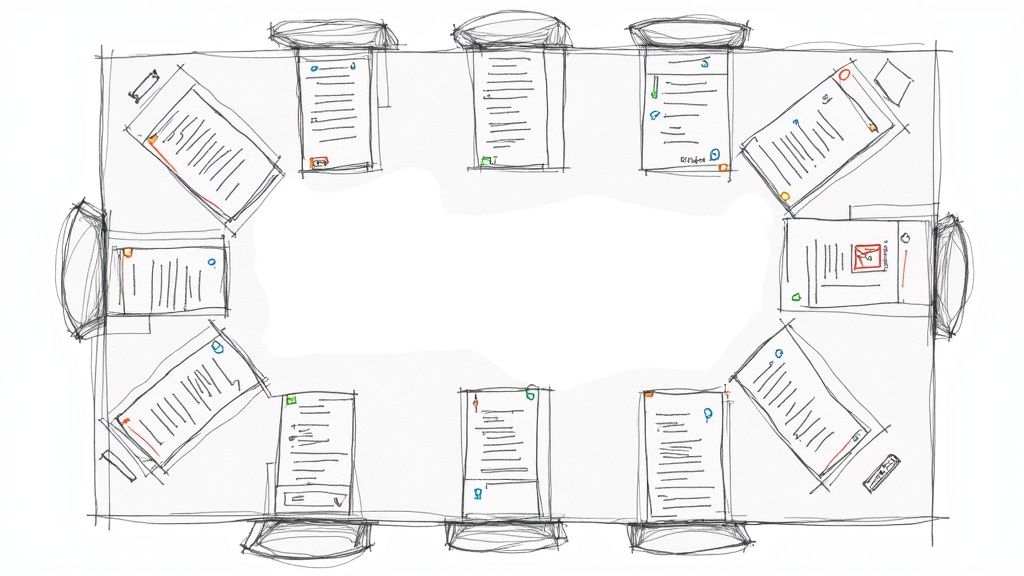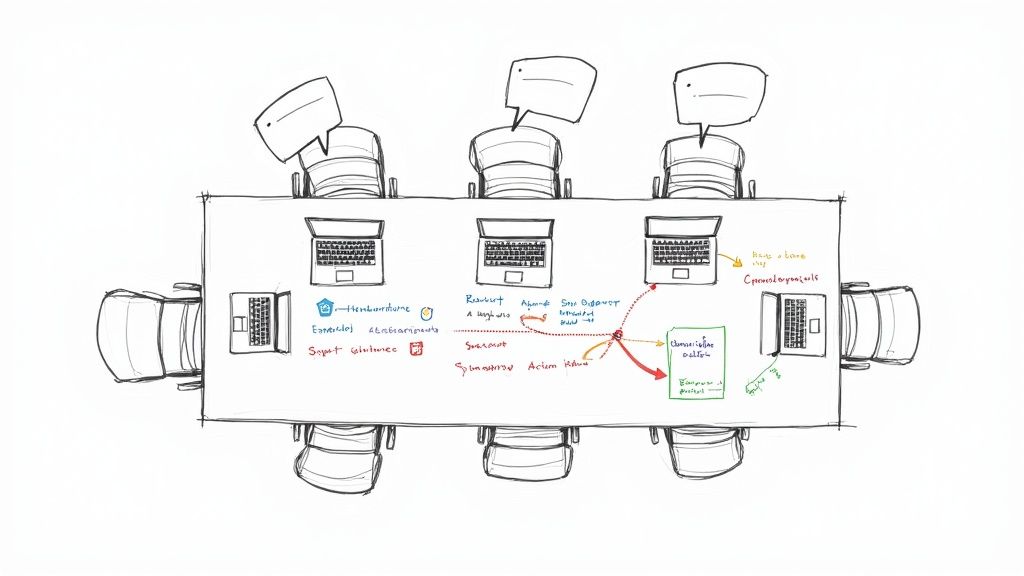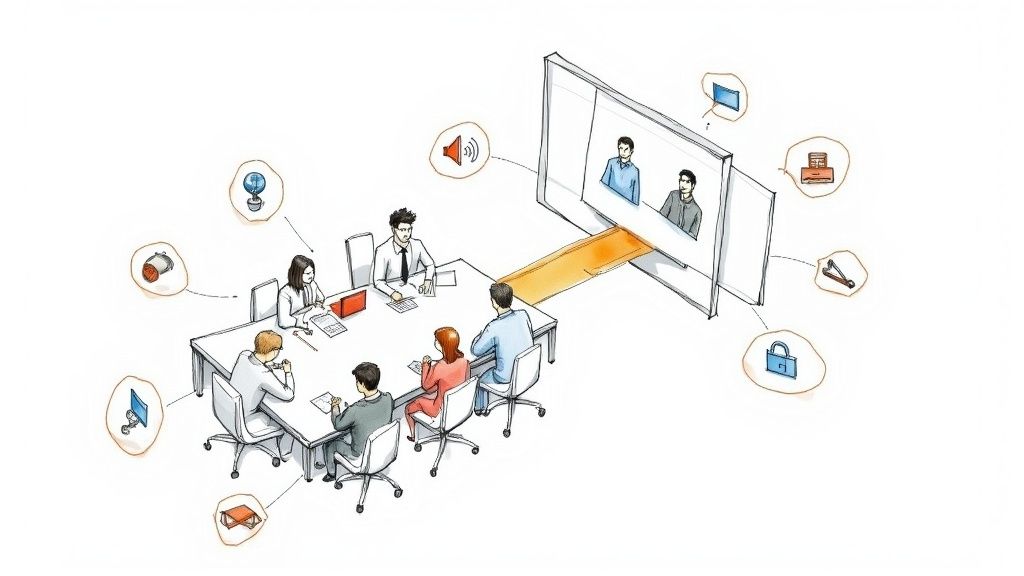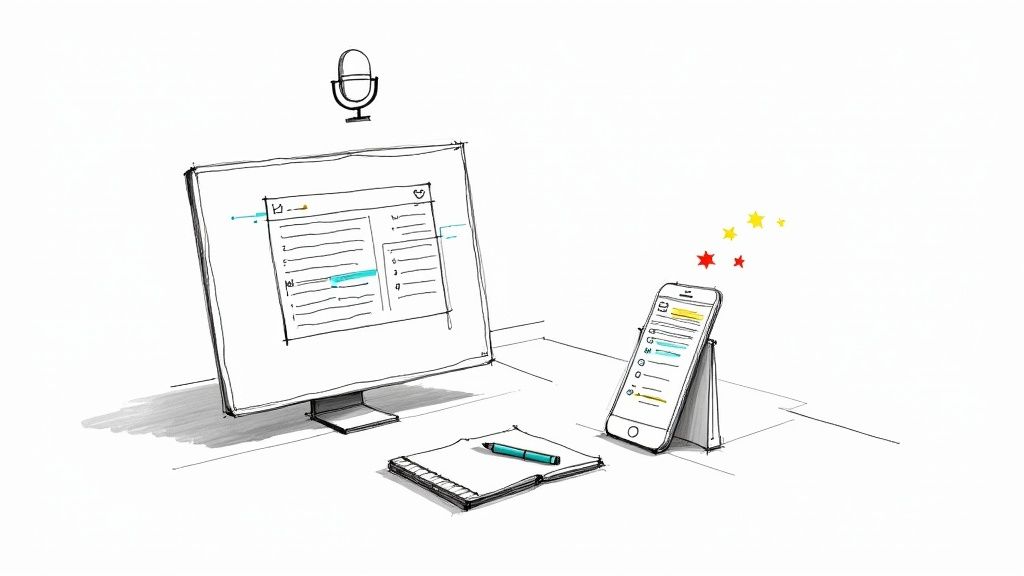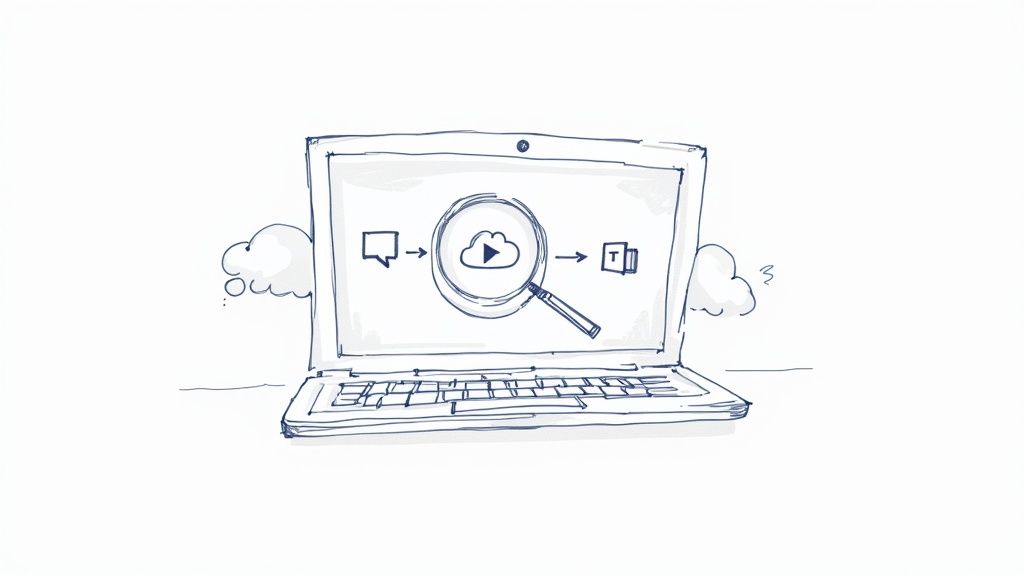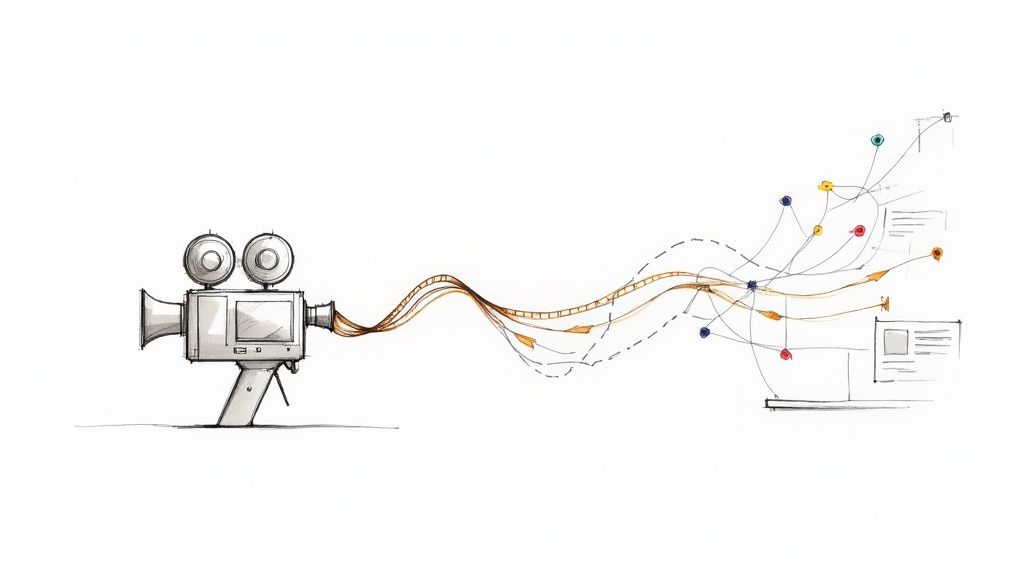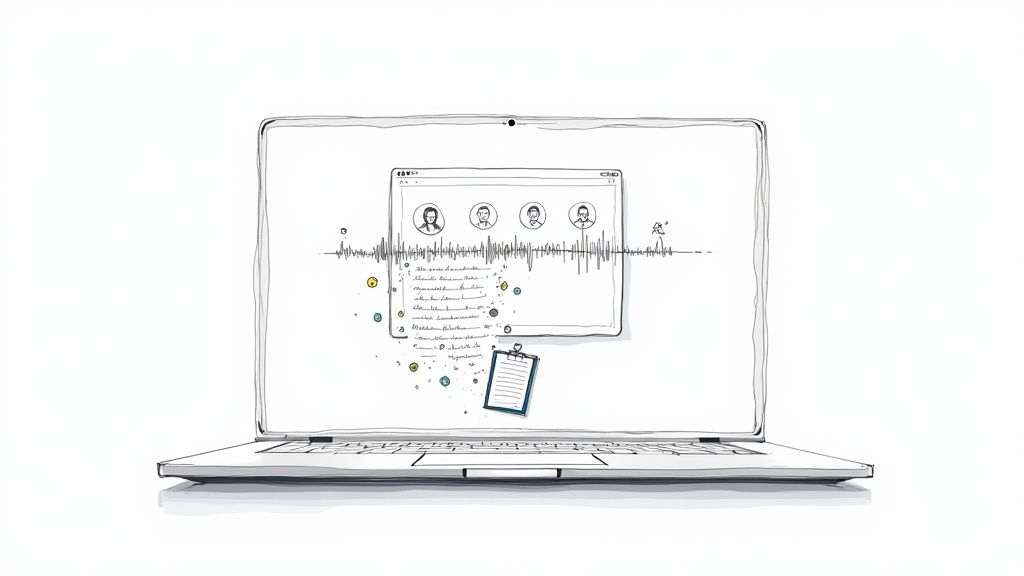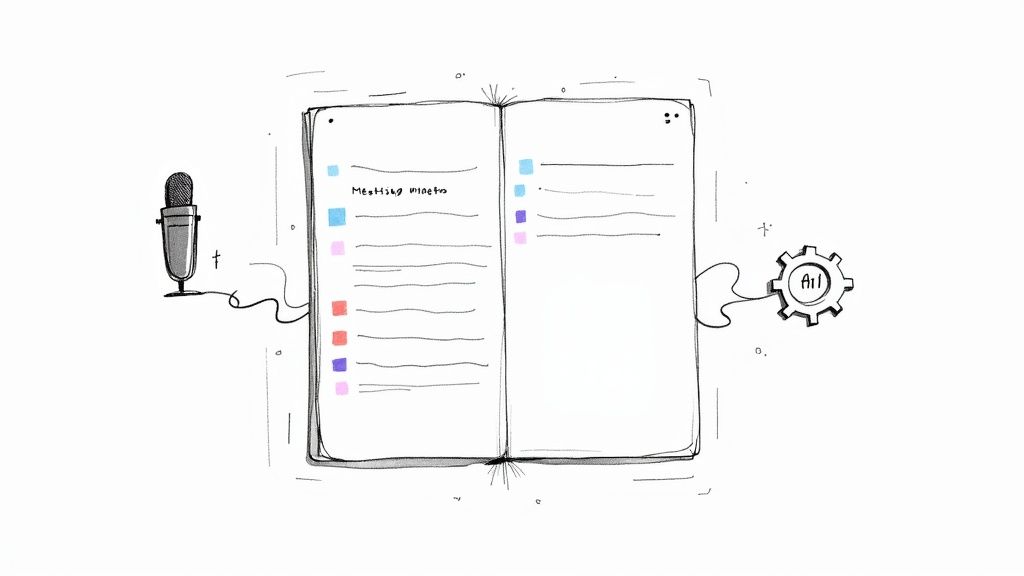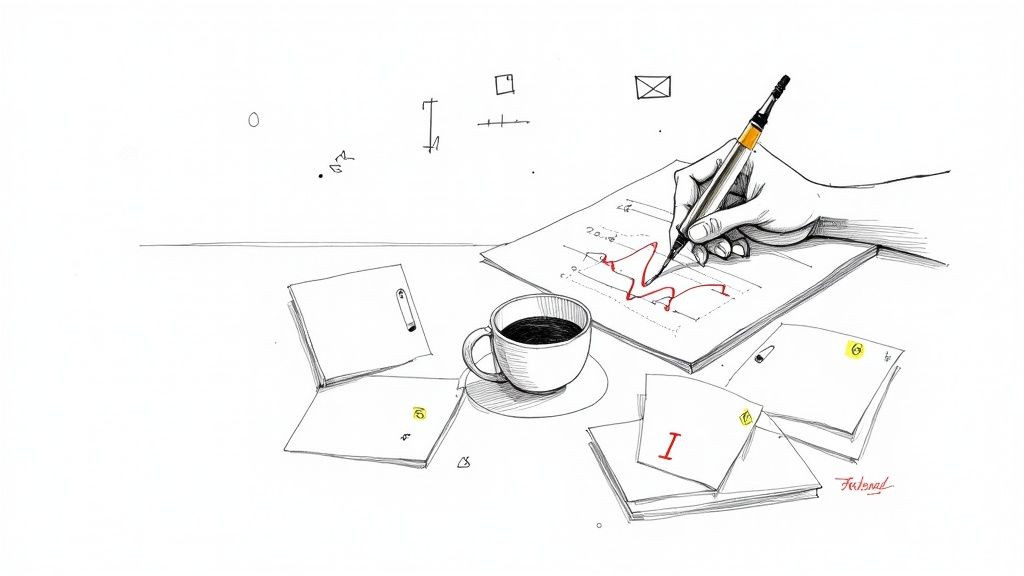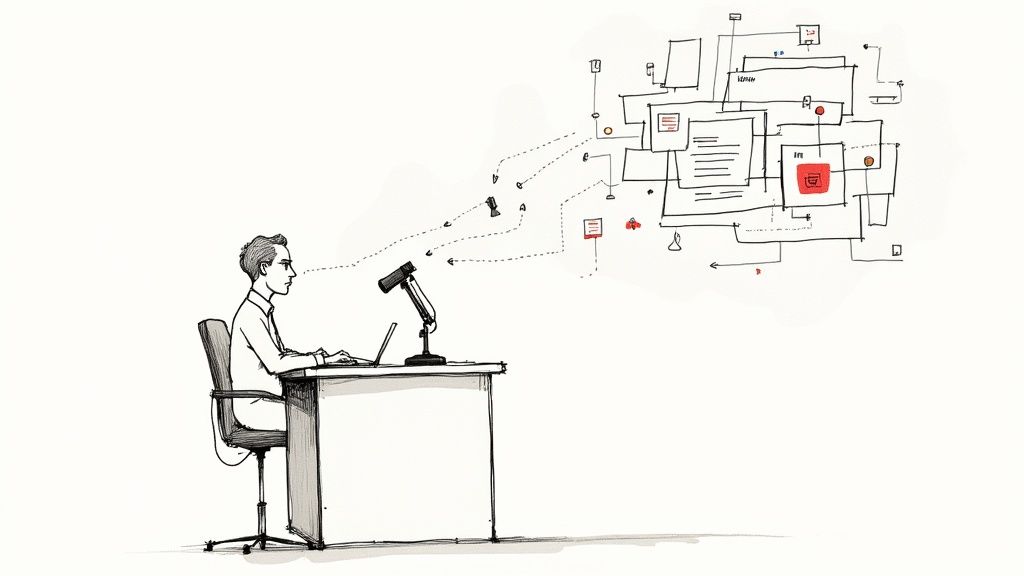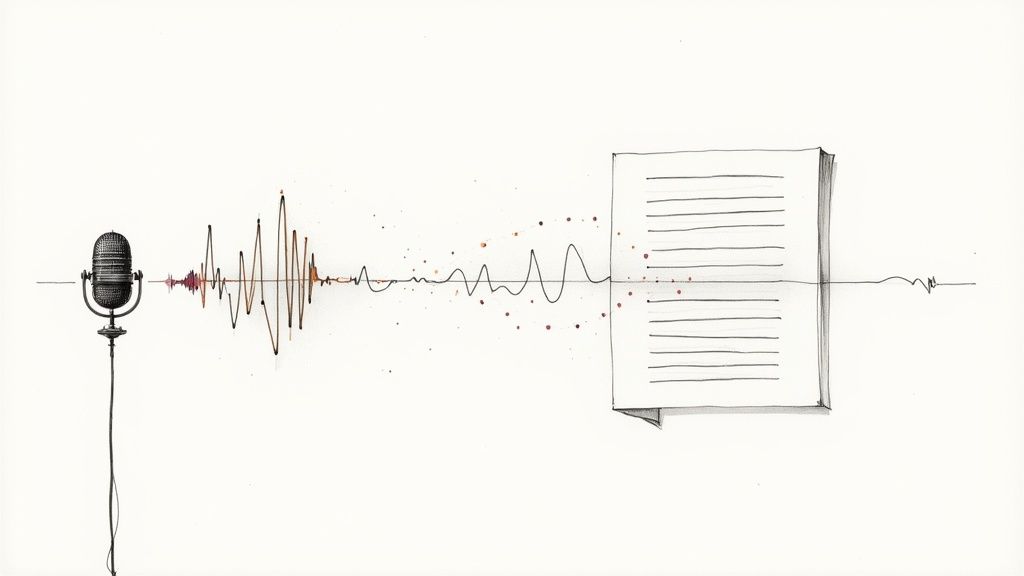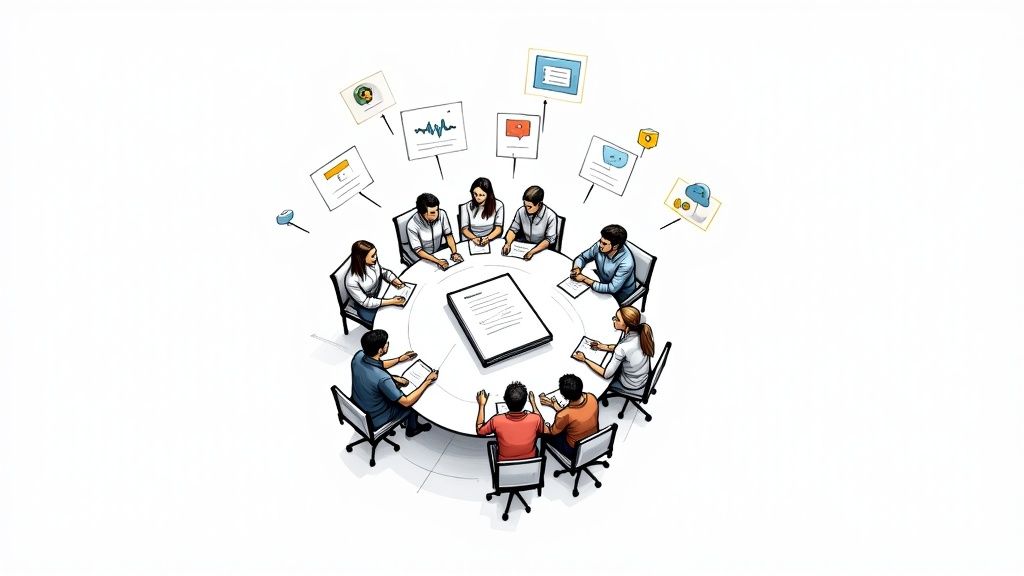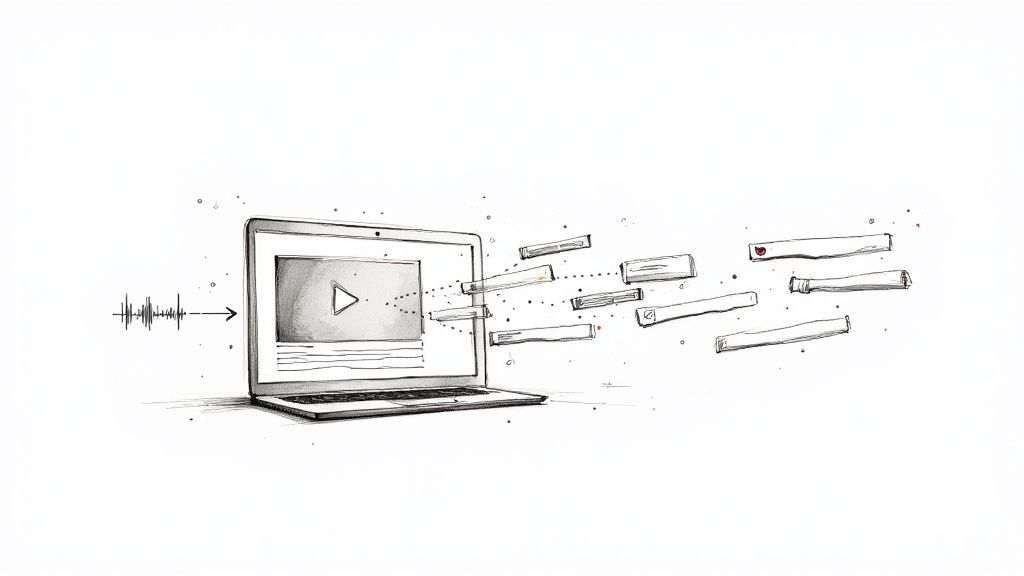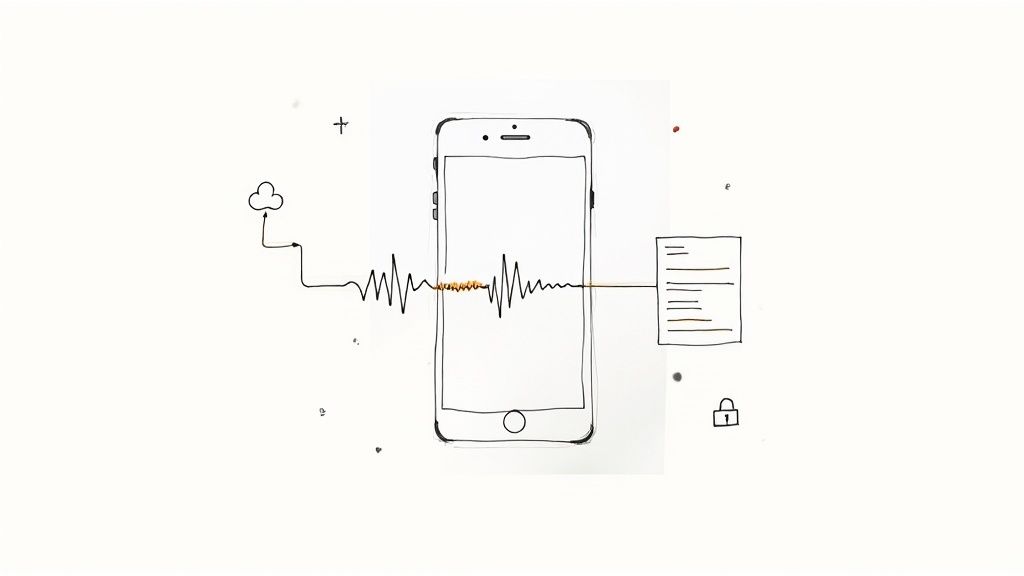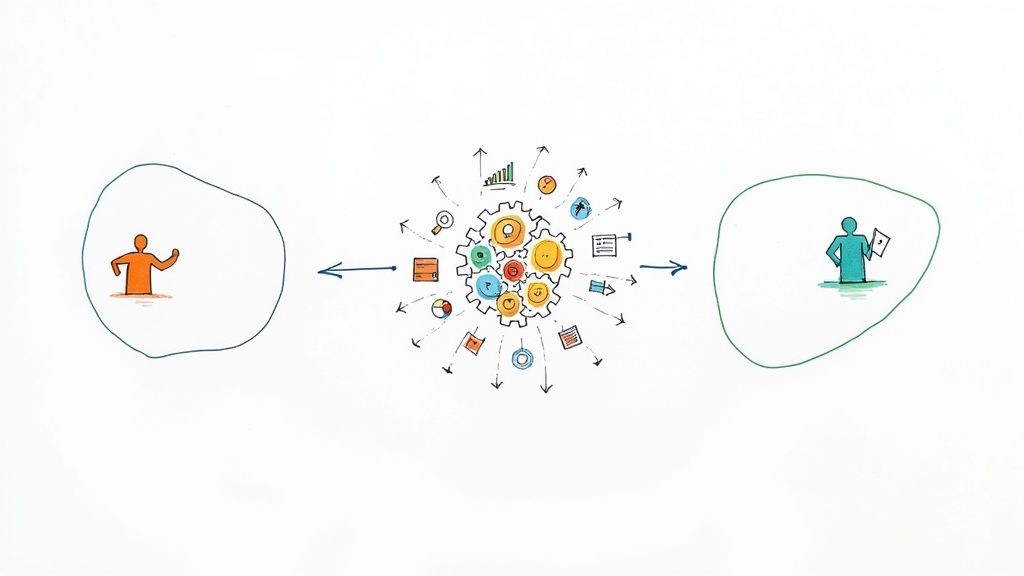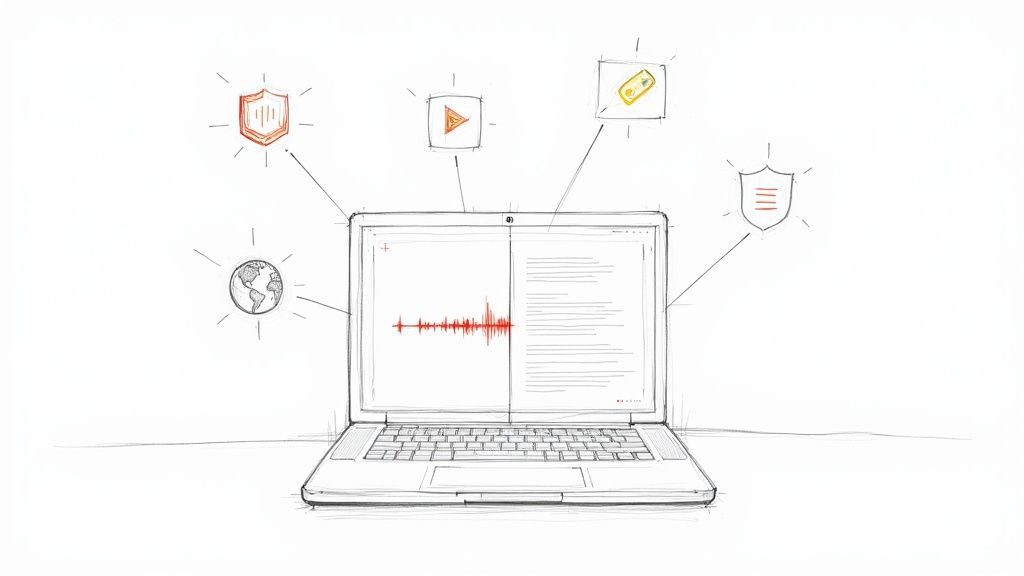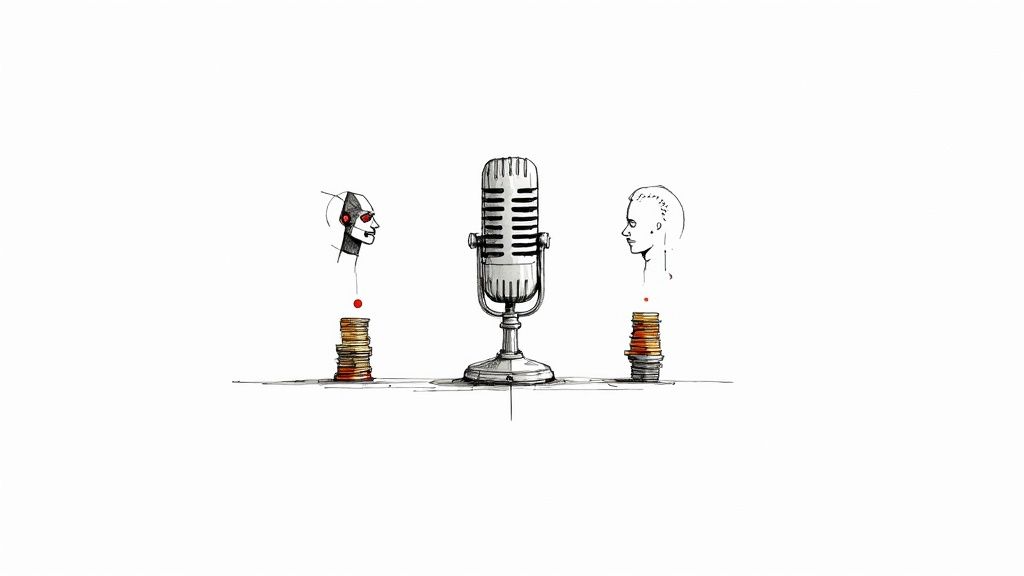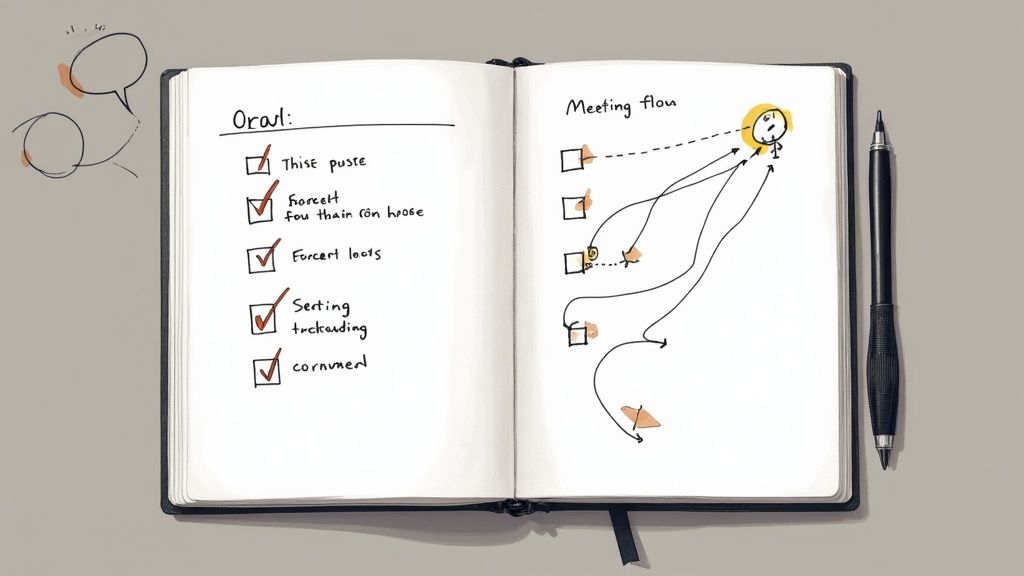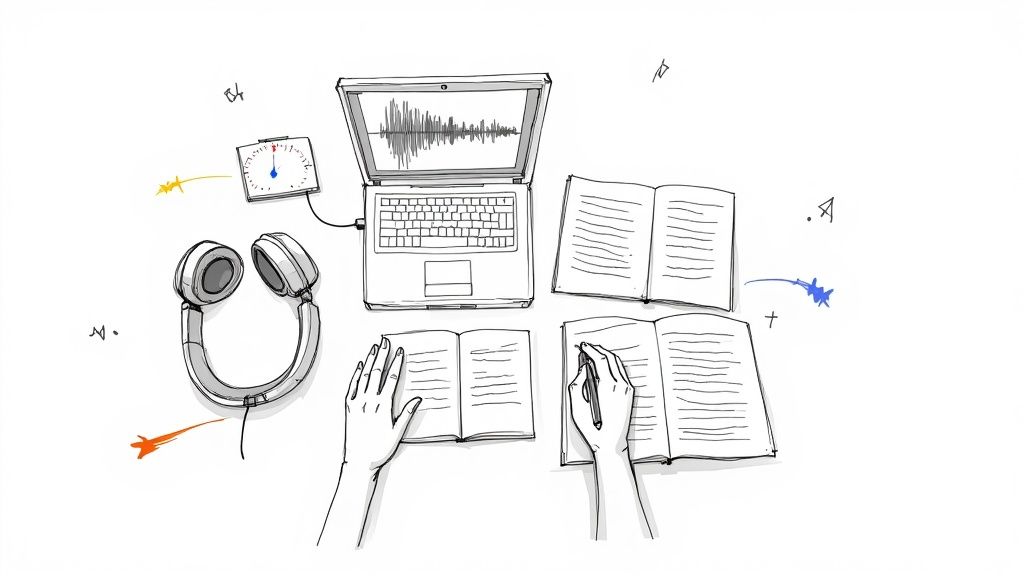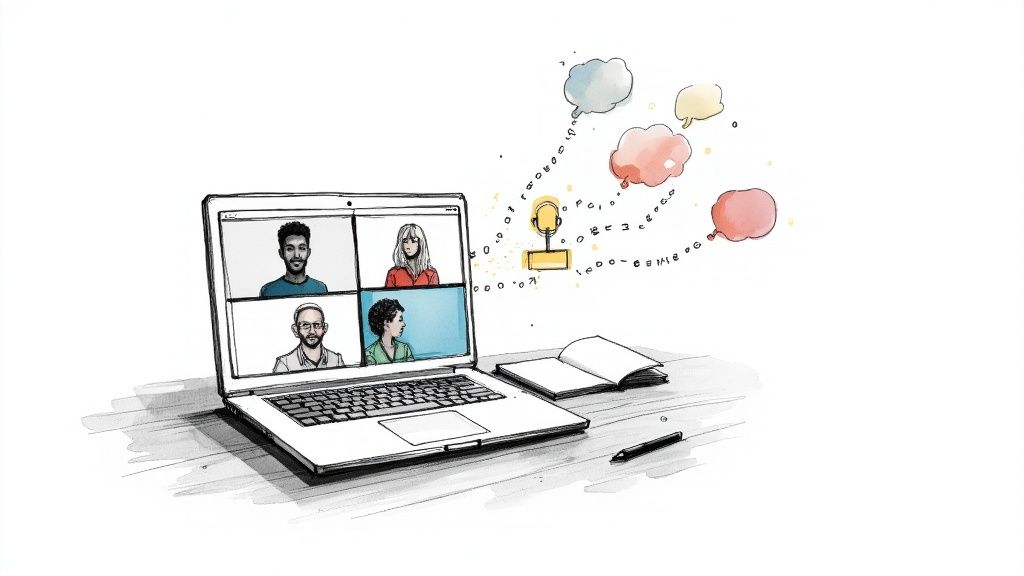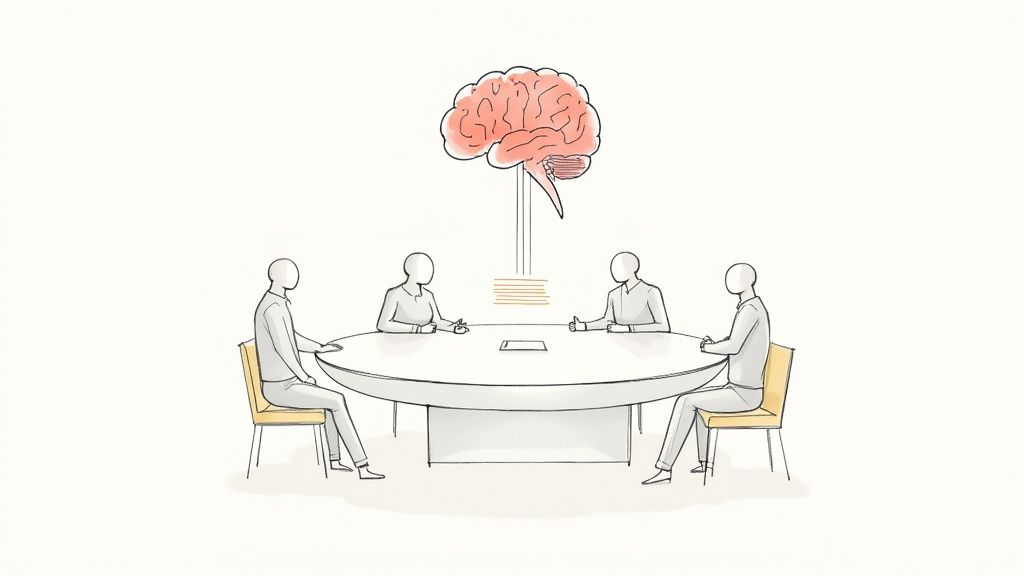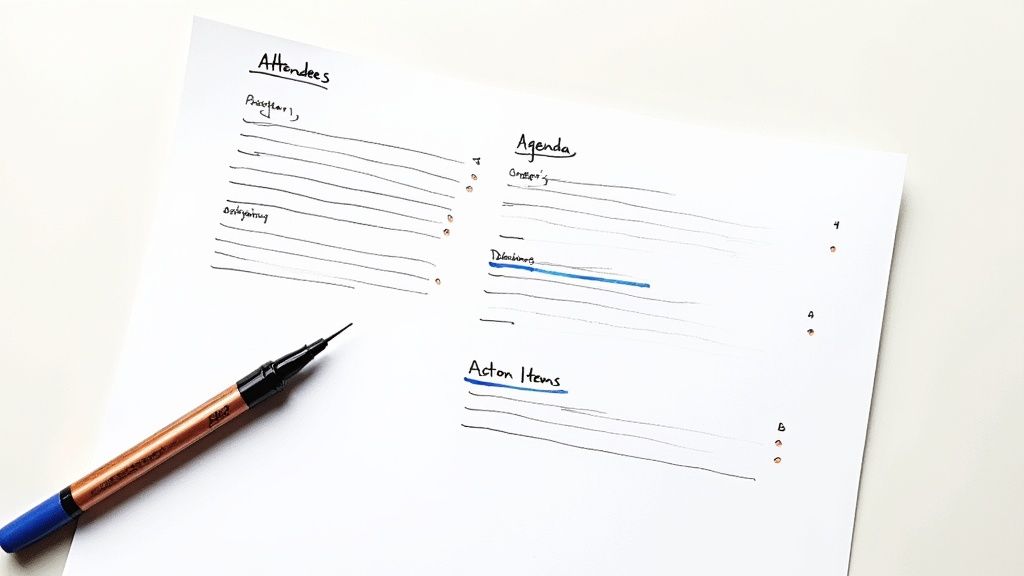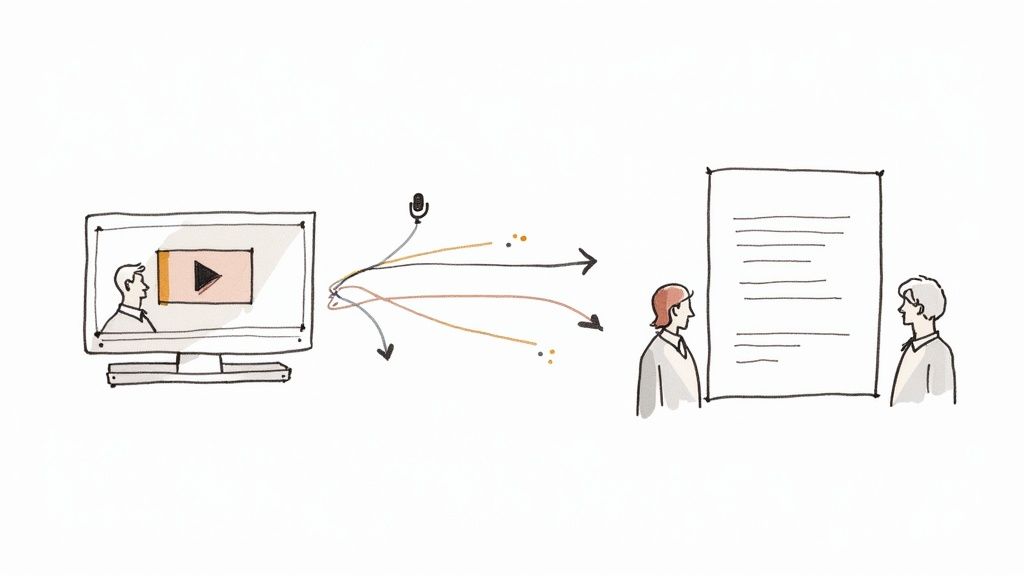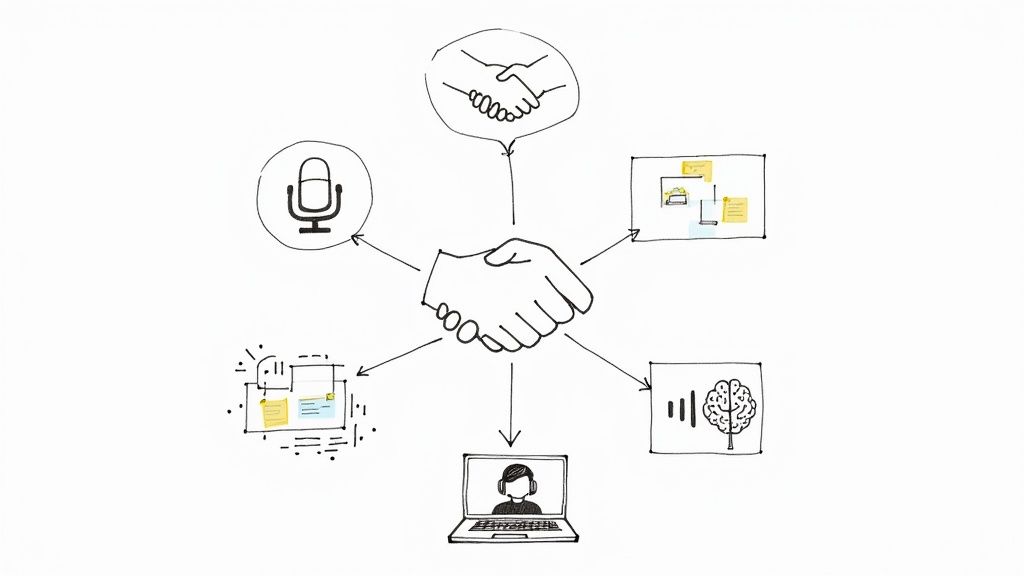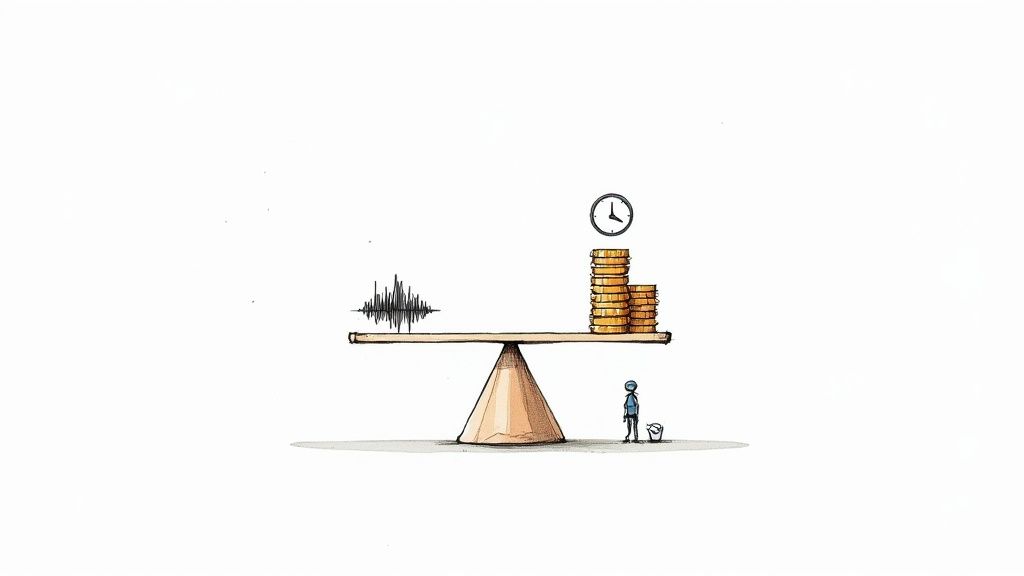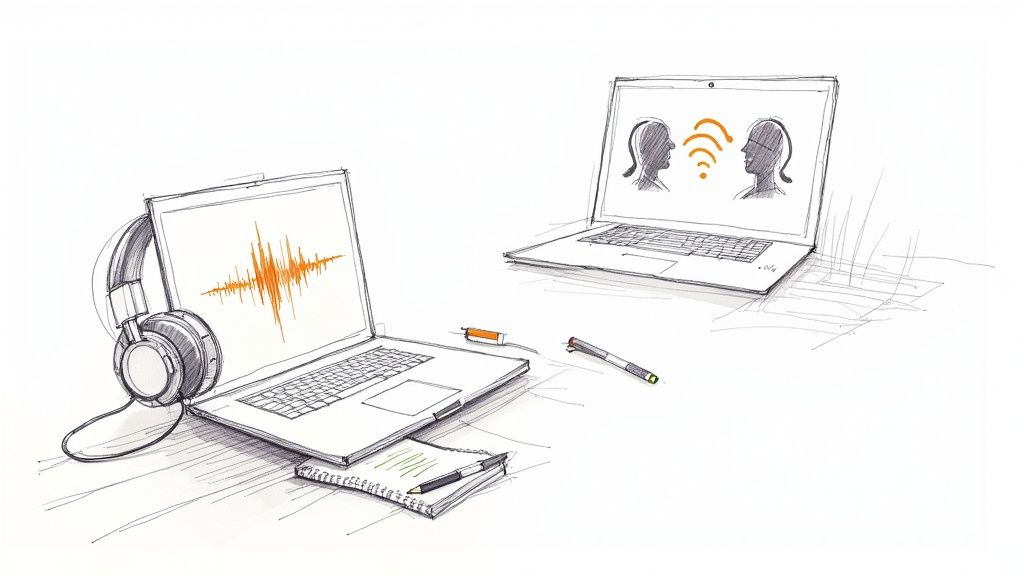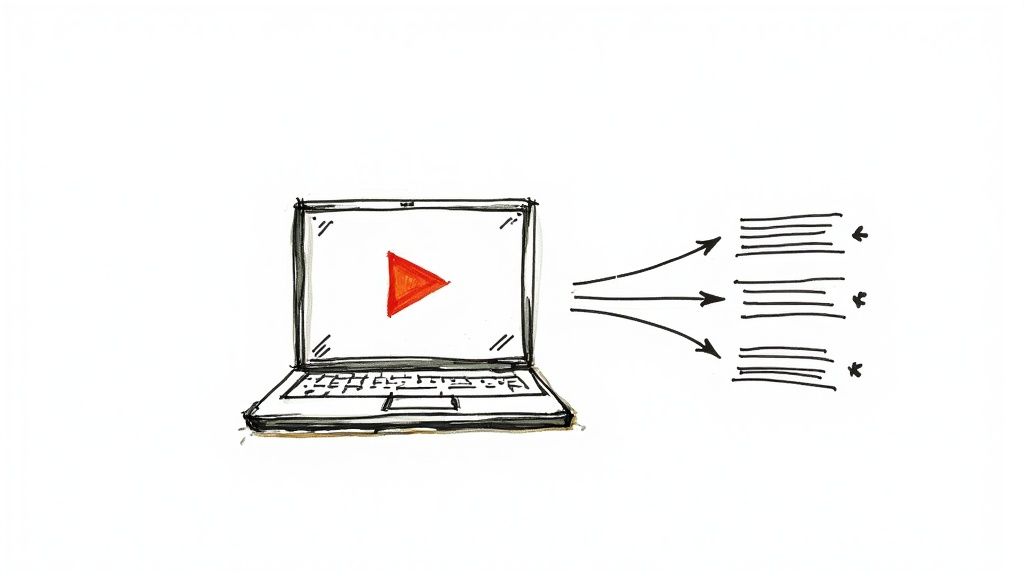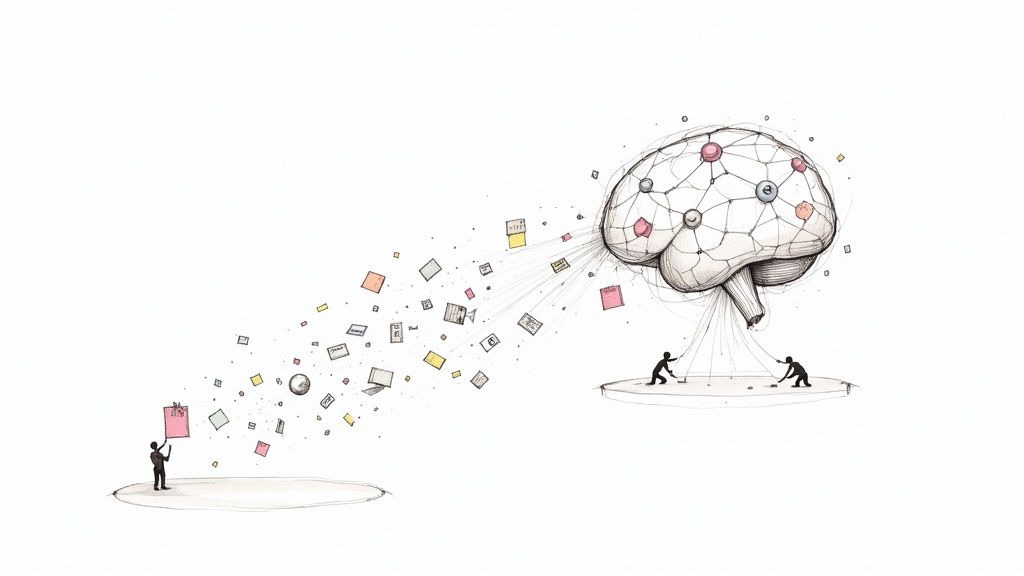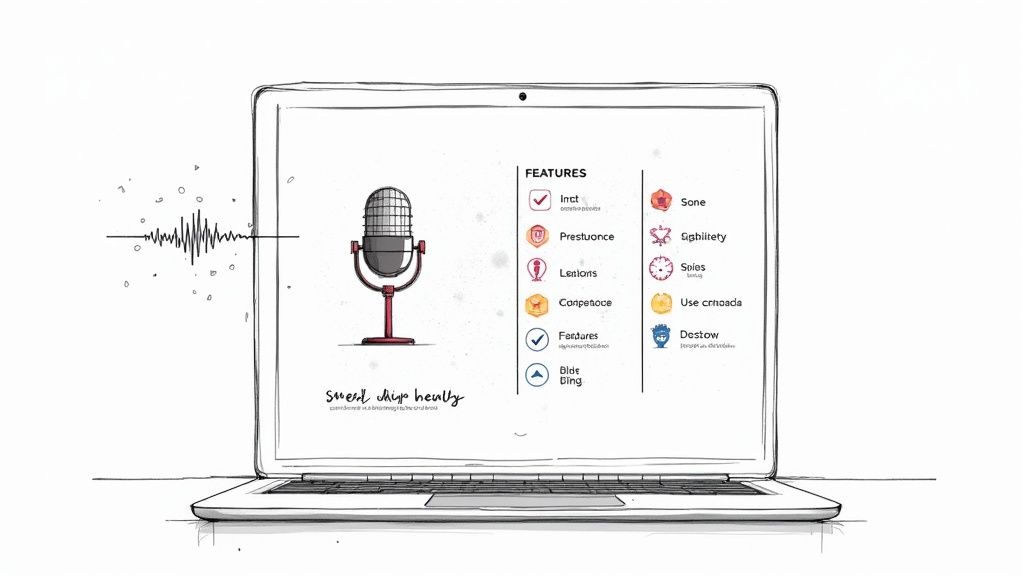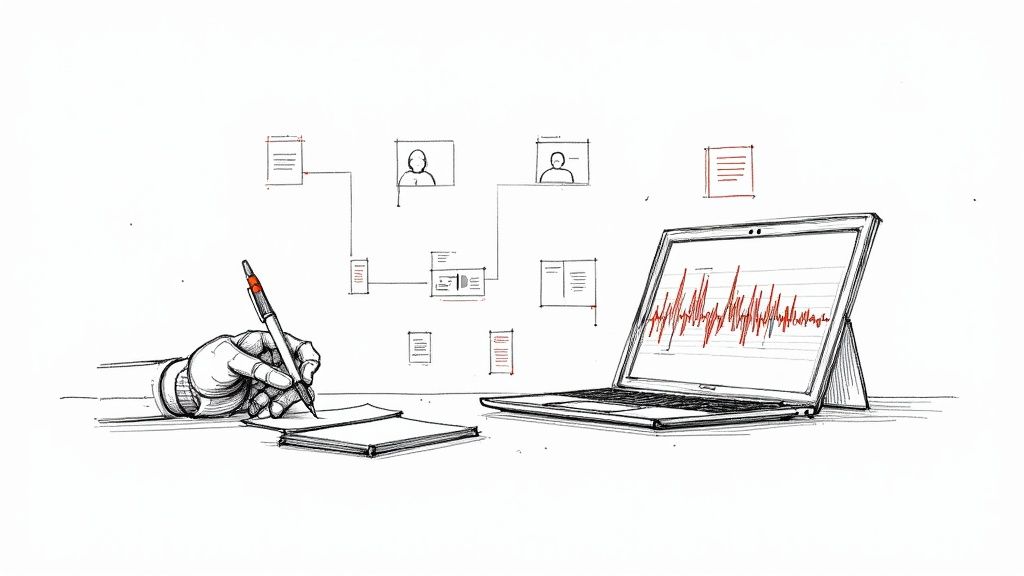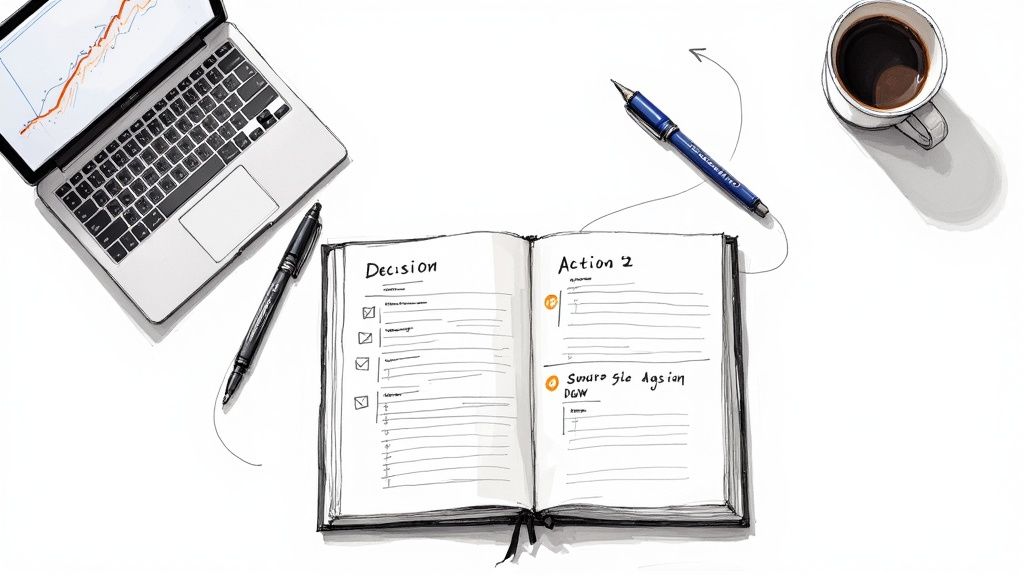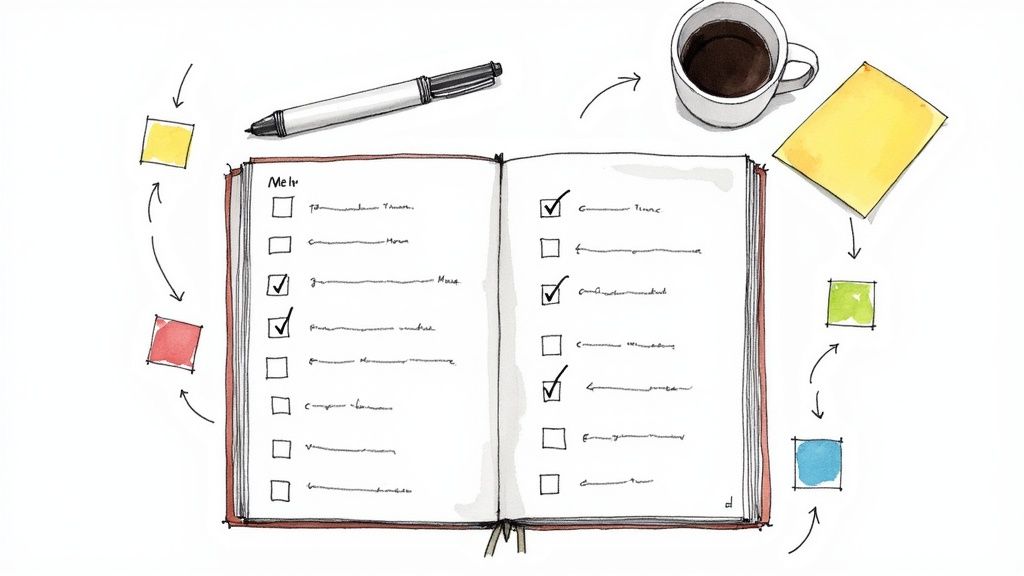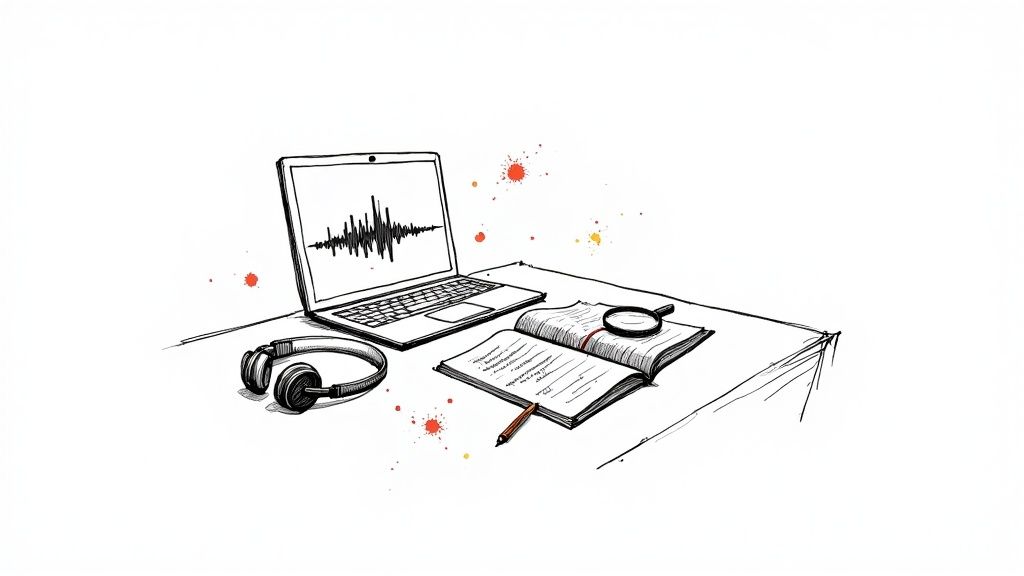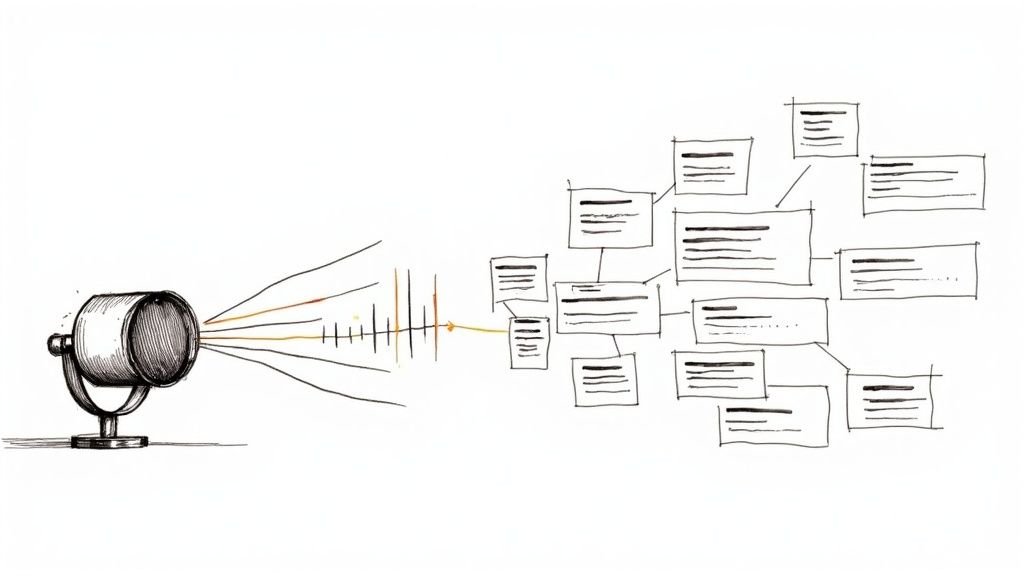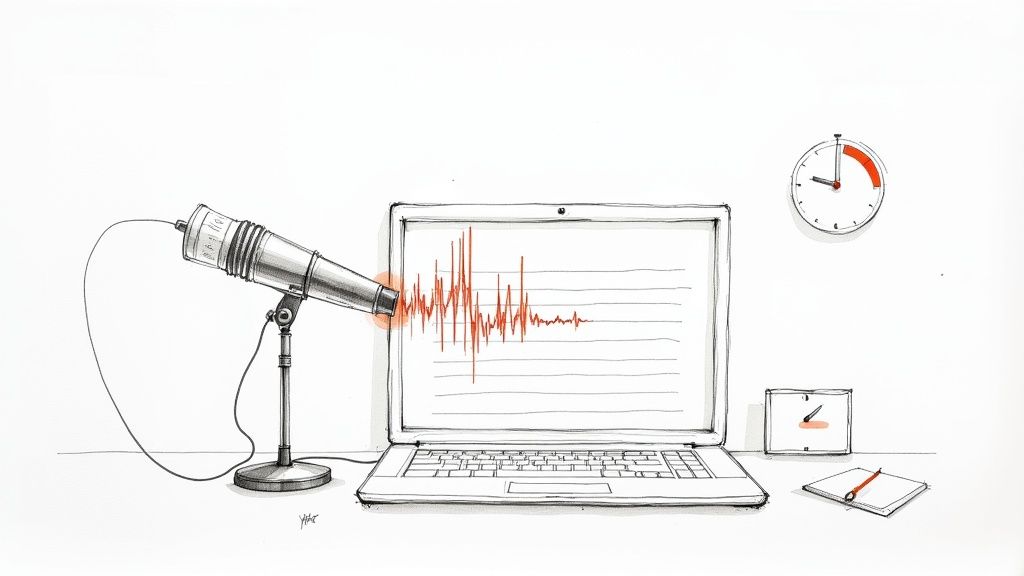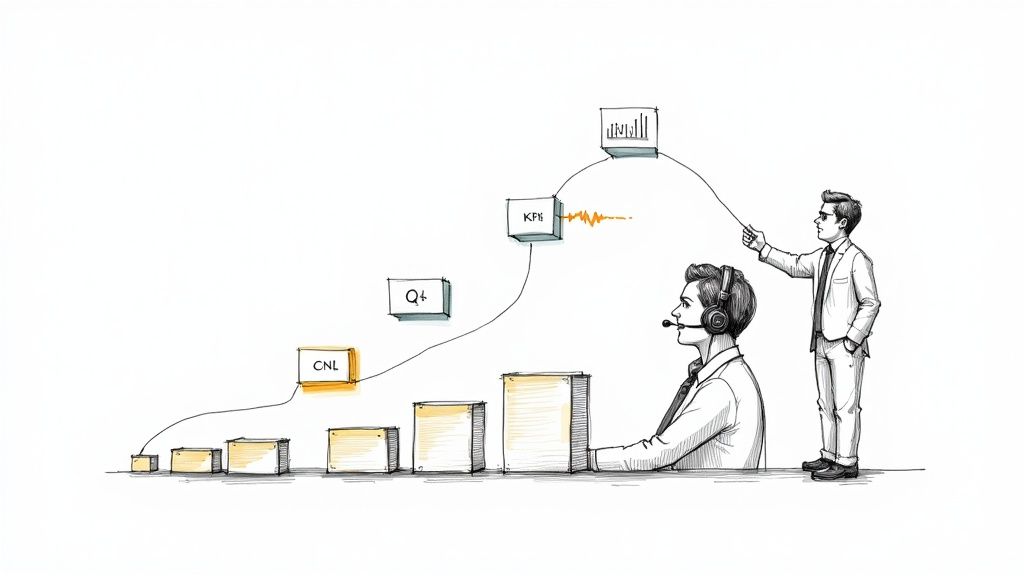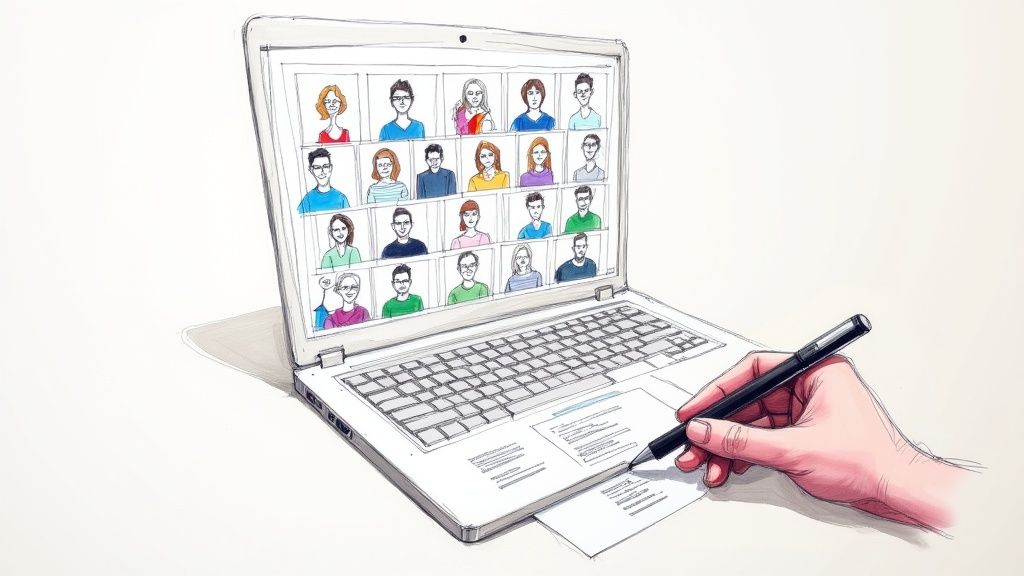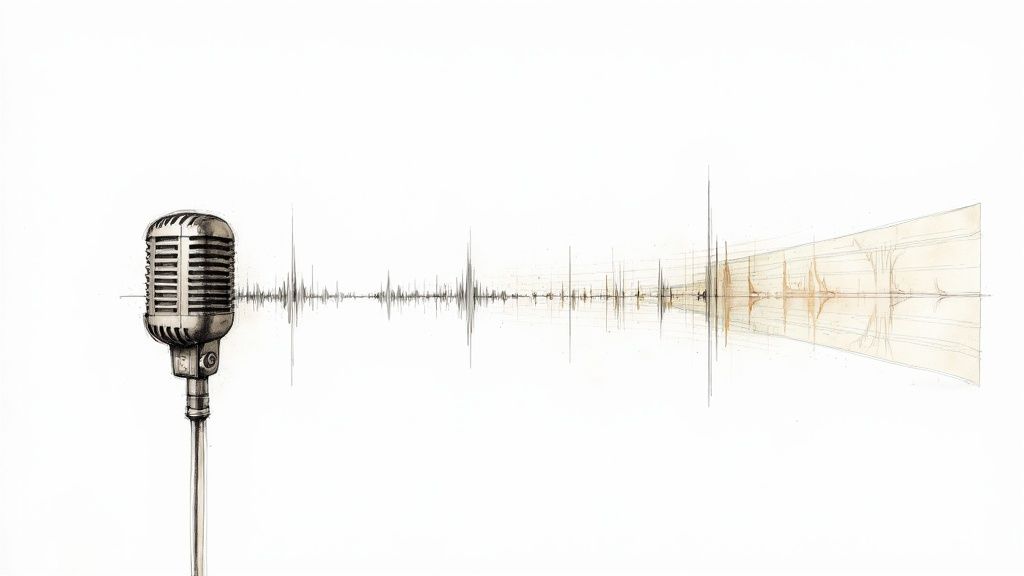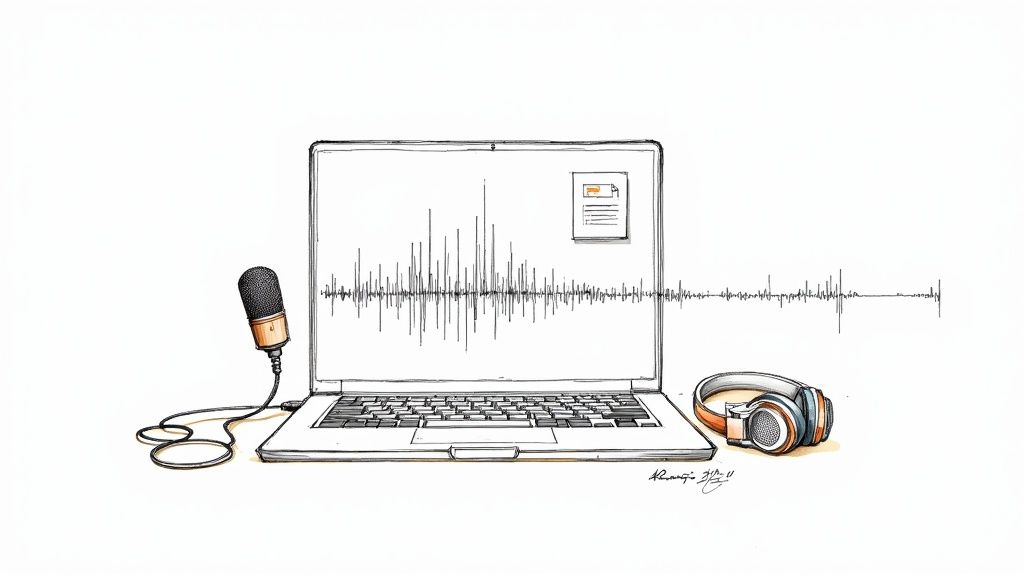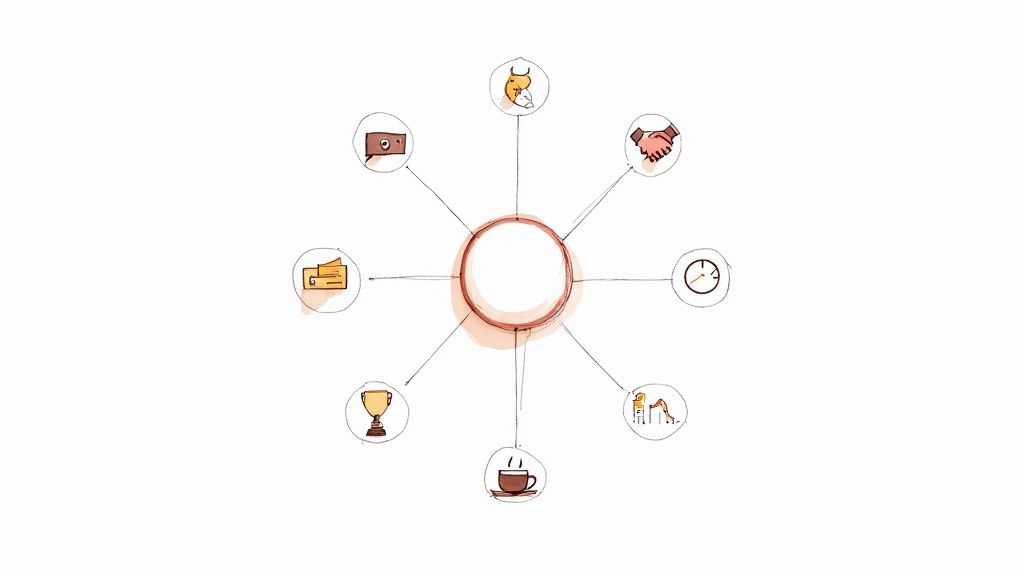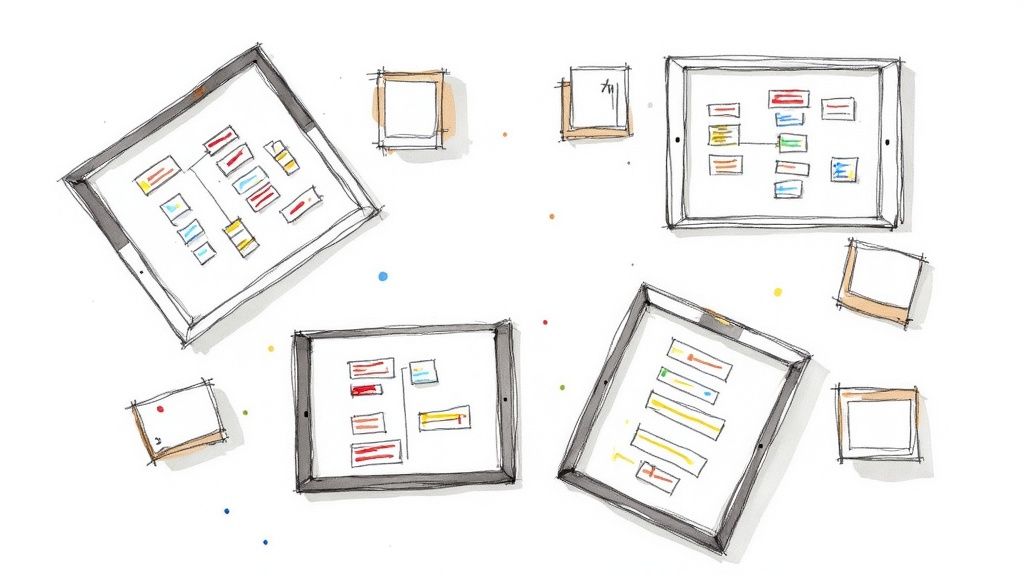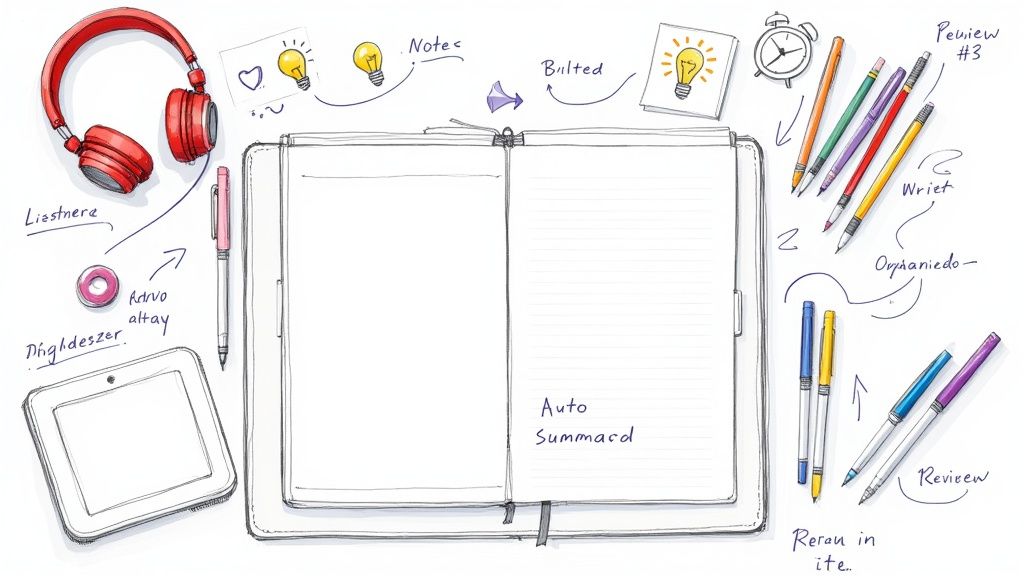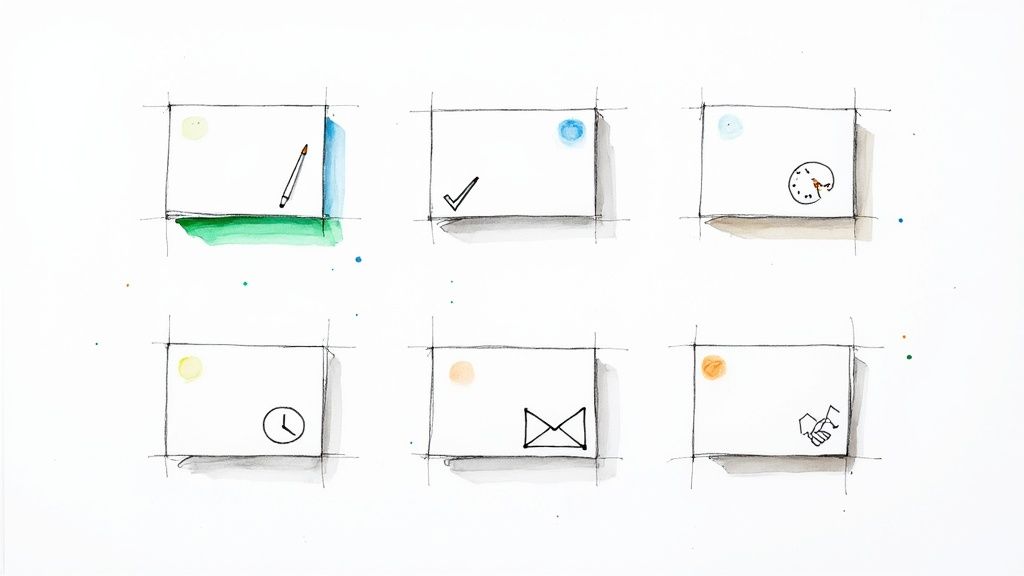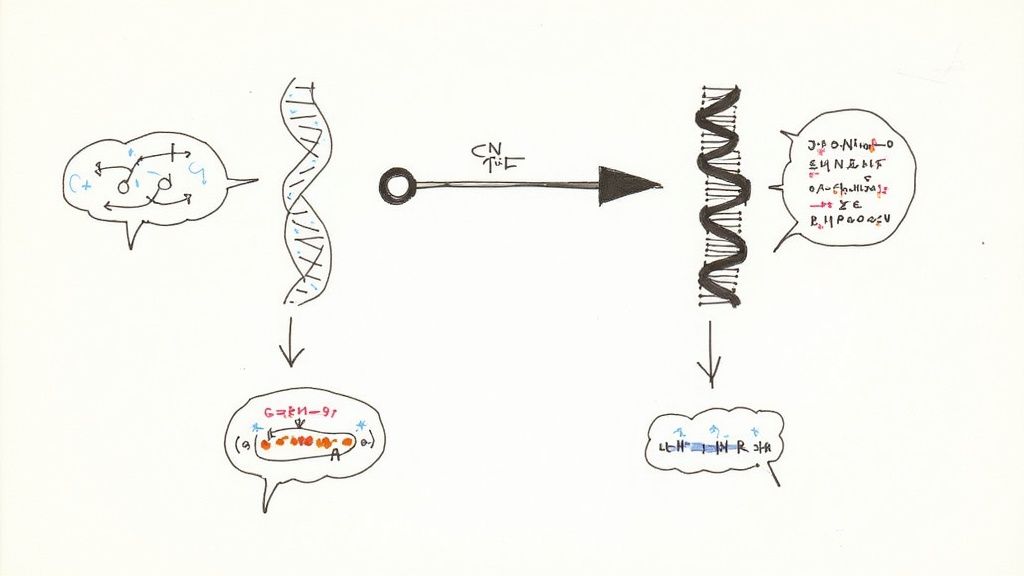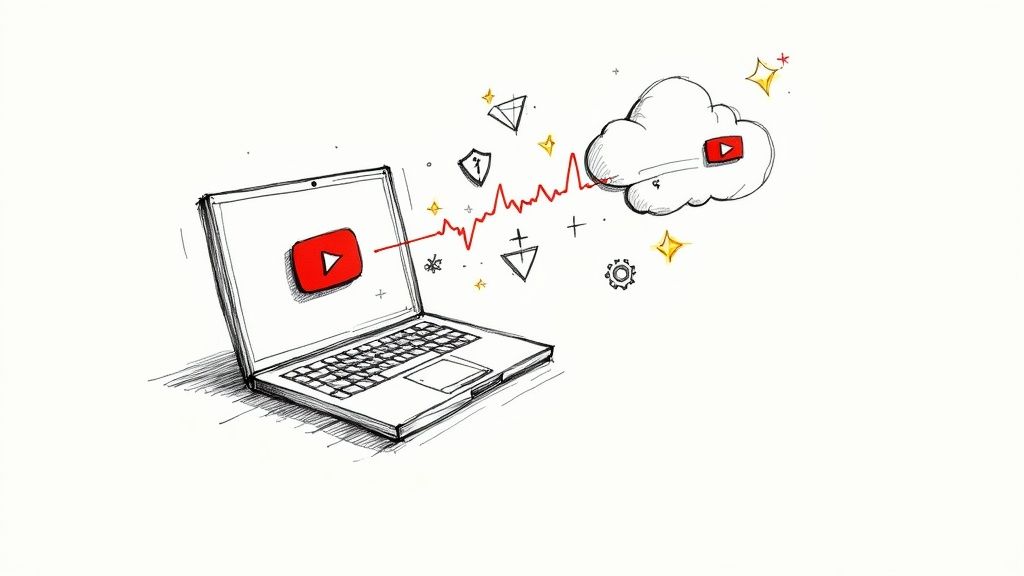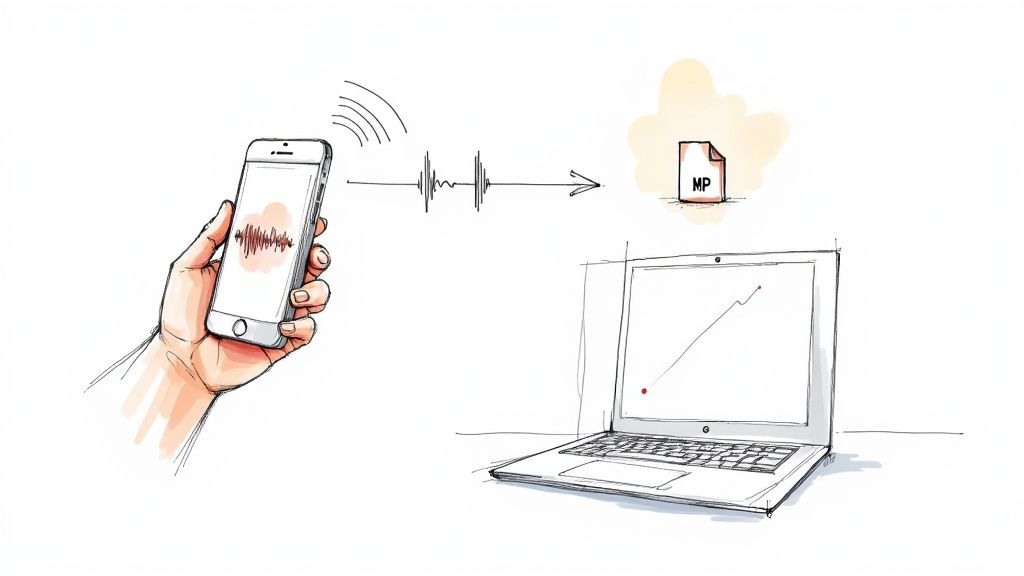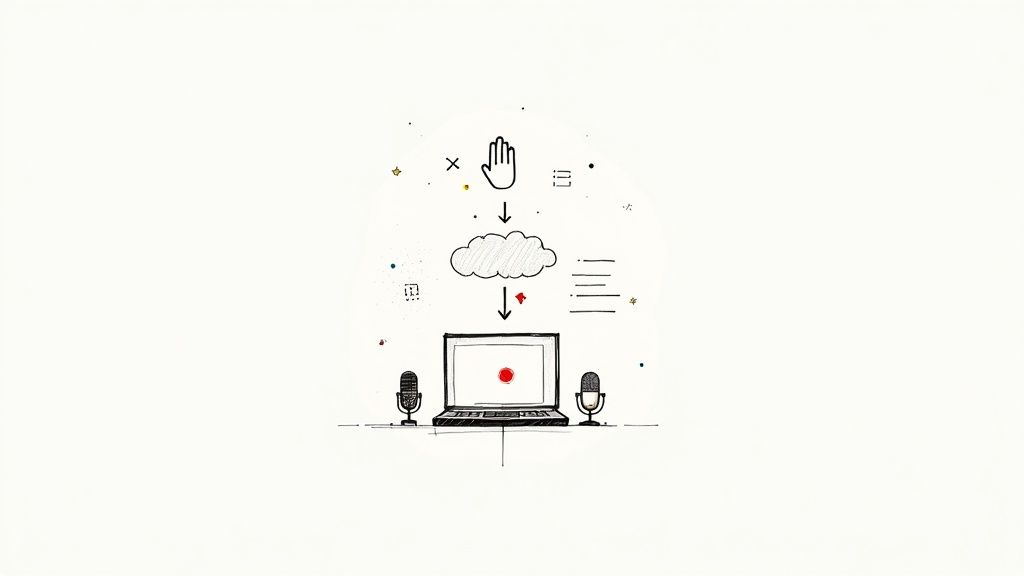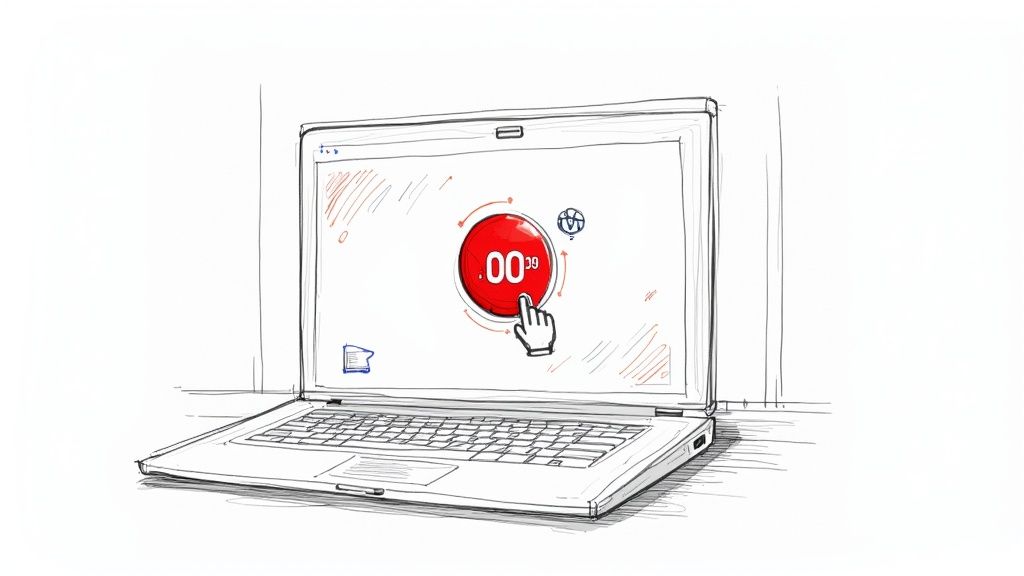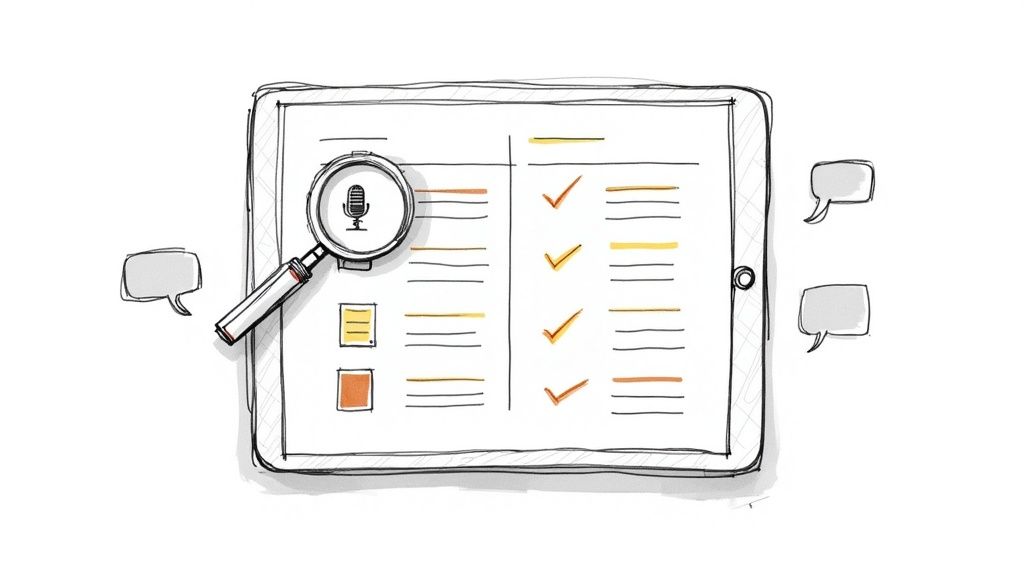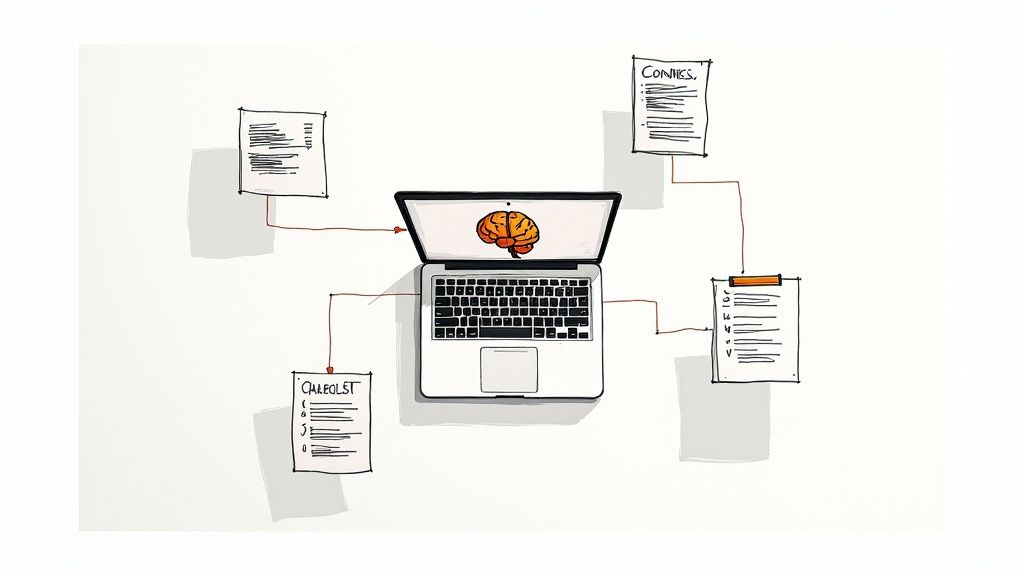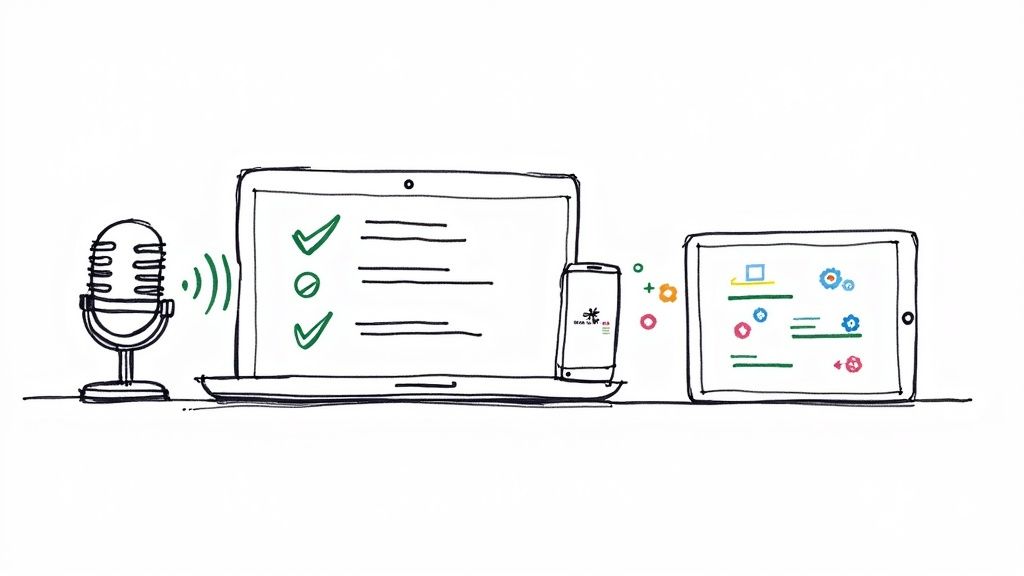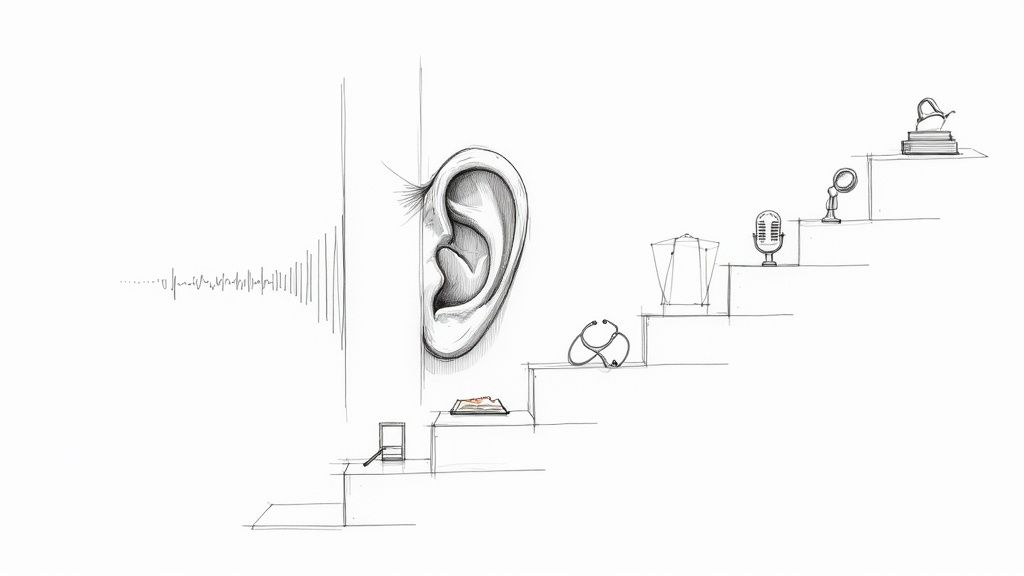A Practical Guide to the Cost of Transcription Services
Trying to figure out the cost of transcription services can be confusing. You see prices as low as $0.10 per audio minute for AI tools and over $1.50 per minute for human experts. This wide range isn't arbitrary; it reflects a fundamental trade-off between speed, accuracy, and what you’re willing to spend. My goal here is to give you a clear, experience-based guide to help you understand what you're paying for and how to choose the right service for your needs.
How Much Do Transcription Services Actually Cost?
So, why the huge difference in pricing? The main reason is you're choosing between two fundamentally different methods: letting an AI do the work or hiring a human professional.
I like to compare it to getting your car cleaned. You can use an automated car wash or have it detailed by hand. The automated wash (AI transcription) is fast and cheap, perfect for a quick clean when a few missed spots are no big deal. A hand detail (human transcription) takes more time and costs more, but the result is a flawless finish that catches every single detail.
A Quick Look at the Price Spectrum
At its core, the cost of transcription services comes down to who—or what—is doing the transcription.
Automated services, powered by artificial intelligence, are your most affordable option. They can turn around clean, simple audio in minutes for just pennies. If you have a straightforward recording with clear speakers, an AI tool can be an excellent choice.
On the other hand, human transcription services command a higher price. That extra cost buys you the critical thinking and nuance that only a person can provide, which is crucial for messy audio. A human transcriber can easily handle things that trip up an AI, like:
- Recordings with multiple people talking over each other
- Audio with background noise or poor acoustics
- Speakers with heavy accents or niche, technical jargon
- Files that require absolute precision, like for legal or medical use
From my experience, when you hire a professional human transcriptionist, you're paying for a guarantee of 99% accuracy. This is a benchmark that AI tools simply can't consistently meet, especially when the audio quality is less than perfect. For anything that needs to be an official, reliable record, that level of accuracy isn't just nice to have—it's essential.
To help you get a clearer picture, here's a quick breakdown of what you can generally expect.
Typical Transcription Service Cost At a Glance
Ultimately, the right service is the one that aligns with your specific needs. If you’re just getting started and want to see how different companies compare, our guide to the best online transcription services is a great resource.
Next, we'll dive into the specific factors that can push your final price up or down.
Decoding the Different Pricing Models
Why does one transcription service charge by the minute while another uses a monthly fee? The cost of transcription services isn't just a random number; it's tied to pricing models designed for different types of users. Understanding these structures is the first step to finding a service that fits your project and your budget, without any unpleasant surprises on the final invoice.
Think of it like choosing how to pay for a meal. You could go for an all-you-can-eat buffet—a single, fixed price where you know exactly what you're spending. Or, you could order à la carte, paying for each individual dish. That might be cheaper if you just want an appetizer, but the cost can climb quickly if you order a full meal. Transcription pricing works in a very similar way.
The Industry Standard: Per Audio Minute
The most common model you'll encounter is per audio minute. This is the transcription world's version of a fixed-price meal. You pay a set rate for every single minute of your audio or video file. It's that simple.
What makes this approach so popular is its predictability. If you have a 30-minute podcast and the service charges $1.50 per minute, you know your final bill will be exactly $45. This clarity makes budgeting easy, which is why both customers and providers prefer it for one-off projects. The cost is directly tied to the length of your file, creating a fair and easy-to-understand system.
This chart breaks down how the per-audio-minute model compares to other pricing structures across different service types.
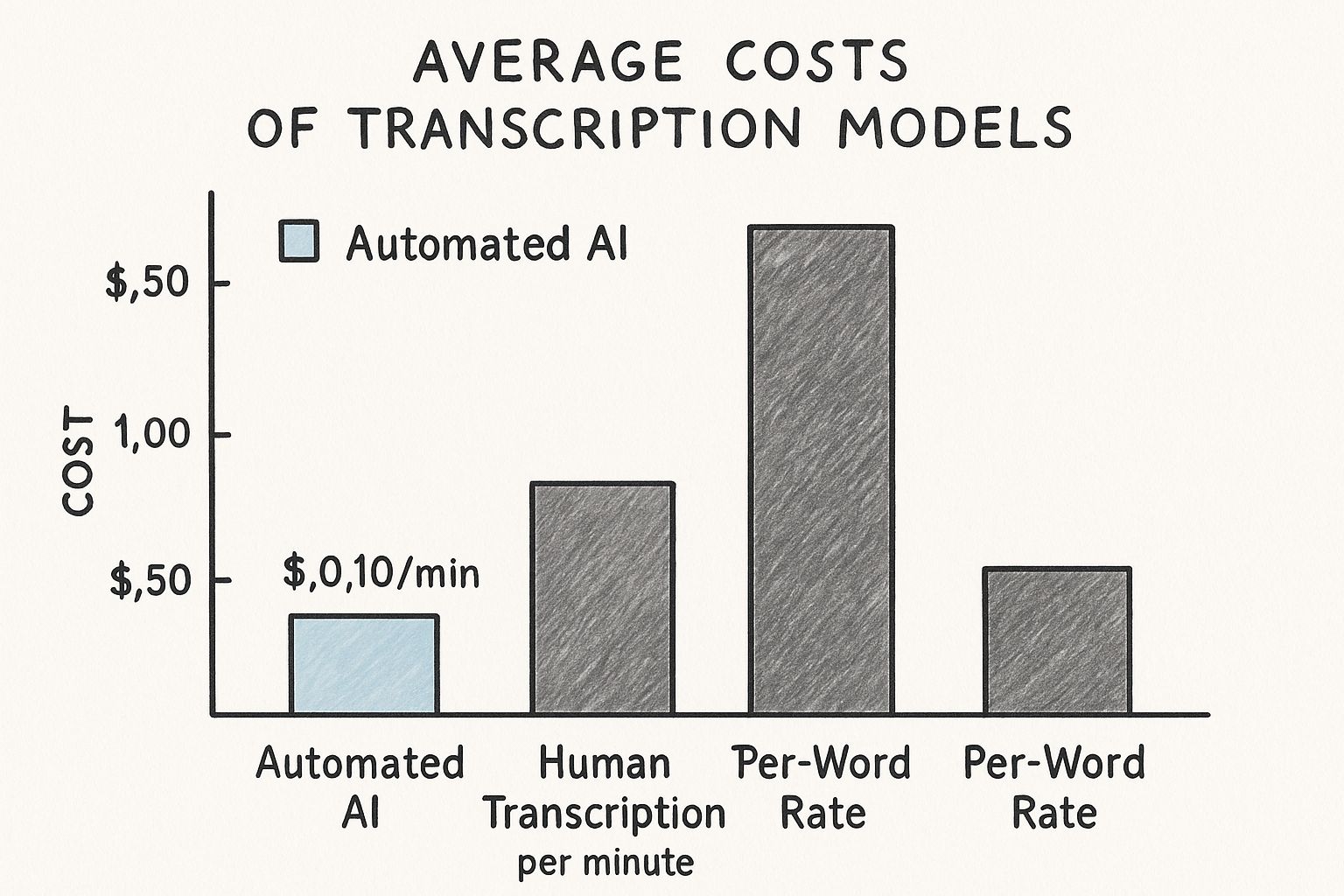
As you can see, services powered by human transcribers naturally have a higher per-minute rate to cover the detailed work involved, while automated AI transcription is a much more budget-friendly option.
Alternative Pricing Structures
While paying by the minute is the most common method, it's not the only option. Other models exist that might be a better fit for your particular project, acting more like that flexible à la carte menu.
Here are a couple of other models you might see:
- Per Word: This is less common but useful for documents where the density of speech is more important than the file's runtime. You're billed for every word in the final transcript. It can be a good deal for recordings with long, silent pauses, but it can get expensive for fast-paced, word-heavy conversations.
- Subscription Plans: You'll see this model with many AI-powered tools like Descript or Trint. You pay a recurring monthly or annual fee for a set number of transcription minutes or hours. This is perfect for anyone with consistent, high-volume needs, like a podcaster transcribing weekly episodes or a team that records every meeting.
In my experience, the best pricing model really comes down to your workflow. If you have one-off projects or only need transcription occasionally, the per-audio-minute model is transparent and simple. But for steady, predictable work, a subscription can offer much better value over time.
Choosing the right model gives you control over the cost of transcription services. When you align the payment structure with your usage frequency, you can ensure you’re only paying for what you truly need.
The Hidden Factors That Drive Up Your Costs
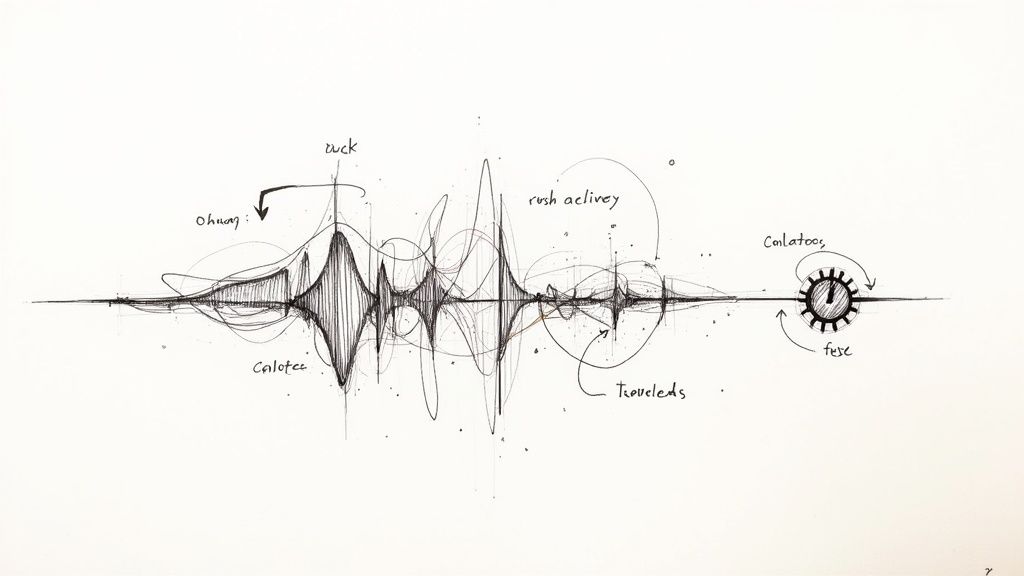
You've got your audio file, you know its length, and you've seen the per-minute rate. The final bill should be simple math, right? Not always. That base rate is often just a starting point. Several "hidden" factors can easily increase the cost of transcription services beyond your initial estimate.
I've learned this firsthand: think of it like getting a quote to paint a room. Painting a clean, prepped wall is straightforward. But if the painter arrives to find they have to repair drywall and strip old wallpaper first, the job becomes much more complex and expensive. The same principle applies to transcription.
Audio Quality Is Everything
The single biggest factor that influences your price is the quality of your audio recording. A professional transcriber working with a crystal-clear podcast interview can complete the work efficiently.
But if that recording is messy, the transcriber’s job turns into a painstaking process of re-listening and trying to decipher muffled words. That extra time and effort will definitely be reflected in your final bill.
Here are the most common audio issues that drive up costs:
- Heavy Background Noise: Chatter in a coffee shop, passing traffic, or a loud air conditioner can obscure words, forcing the transcriber to replay sections repeatedly.
- Poor Microphone Quality: Recording from across the room with a laptop mic results in muffled, echoey audio that’s a nightmare to transcribe.
- Low Bitrate or File Compression: Heavily compressed audio files lose a lot of clarity. If you're working with a low-quality file, you might need to learn how to convert a voice memo to MP3 to preserve as much detail as possible.
The Complexity of the Conversation
Beyond audio clarity, the content of the conversation plays a huge role. A simple one-on-one interview is far easier to transcribe than a chaotic focus group discussion. The more complex the interaction, the higher the cost.
This is because the transcriber has to do more than just type what they hear; they have to actively interpret who is speaking and when, which requires significant mental effort and time.
A recording with three or more speakers can often add $0.25 to $0.75 per minute to your bill. This surcharge covers the extra time needed to accurately identify and label each person's dialogue, especially when they interrupt or talk over one another.
This kind of complexity is a major driver in the U.S. transcription market, which was valued at USD 30.42 billion in 2024 and continues to grow. The high demand for accurate records in fields like law and media, where multi-speaker recordings are common, directly influences pricing across the board. You can dive deeper into the U.S. transcription market trends to see how these factors connect.
How Different Factors Impact Your Final Price
To put it all together, here’s a quick-glance table showing how these variables can affect your quote. Think of the "Low Cost" column as your ideal scenario and the "High Cost" column as a project that will require more investment.
As you can see, a project that checks multiple "High Cost" boxes can quickly become much more expensive than the advertised base rate.
Other Cost-Impacting Factors
Finally, a few specific service requests and technical needs will also increase your final price. A standard transcript is one thing, but specialized add-ons require more resources.
- Turnaround Time: Need that file back in a few hours instead of a few days? Rush delivery almost always comes with a premium fee.
- Verbatim Style: Capturing every single "um," "ah," false start, and stutter (full verbatim) requires intense focus and significantly more time.
- Technical Jargon: If your audio is full of dense medical, legal, or scientific terms, you'll need a specialized transcriber with subject-matter expertise. That expertise costs more.
Choosing Between Human and AI Transcription
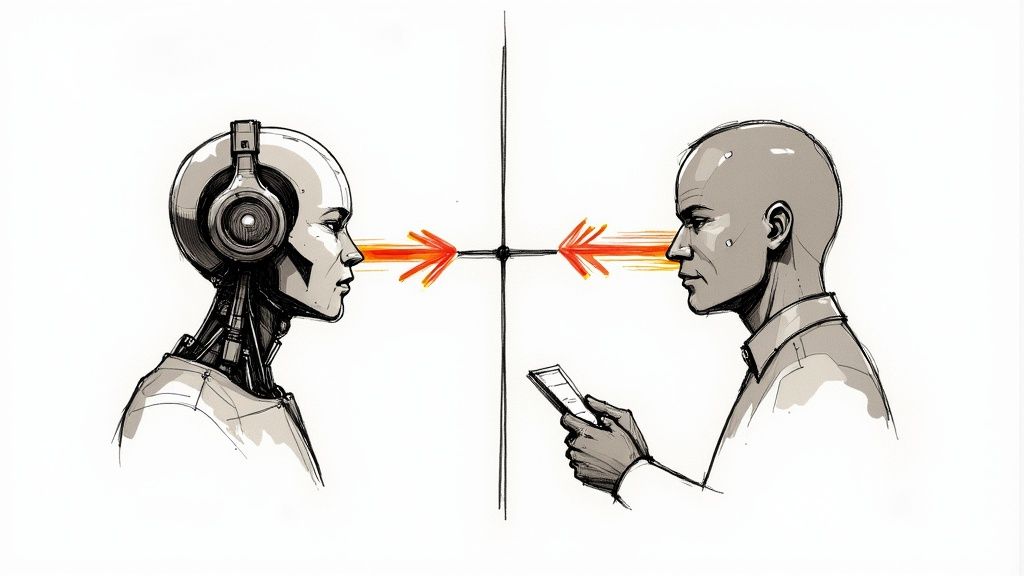
When it comes to transcription, you’re often faced with a choice: do you go with a human expert or an AI? The best path forward depends entirely on your project's specific needs. It’s a classic balancing act between the cost of transcription services and the level of accuracy and nuance your work requires.
AI-powered transcription has advanced significantly, offering incredible speed at a very low price. If you just need to turn a clean, single-speaker lecture into searchable text or get the gist of a high-quality interview, an automated tool is often a great choice. It's fast, affordable, and delivers a transcript that’s perfectly usable for many situations.
But the moment things get complicated, the value of a human transcriber becomes obvious.
When to Invest in Human Accuracy
As smart as AI has become, it still struggles with the uniquely human aspects of speech. A machine doesn't understand sarcasm, context, or the meaning behind a pause. This is where a human professional truly excels.
Based on my experience, you should always opt for a human service in scenarios like these:
- High-Stakes Content: Think legal depositions, medical notes, or any file where a single mistake could have serious consequences. Professional human services often guarantee 99% accuracy, a promise that AI simply can't keep with messy audio.
- Complex Audio: Have a recording with people talking over each other, background noise, or speakers with heavy accents? AI will likely produce a jumbled transcript. A human has the patience and cognitive ability to untangle it.
- Need for Context: A human can pick up on industry-specific jargon, correctly identify speakers, and follow the natural flow of a real conversation in a way algorithms can't yet manage.
When AI Transcription Makes Sense
On the other hand, AI is the undisputed champion of speed and volume. For anyone needing to process a large amount of audio without breaking the bank, automated transcription is the way to go.
Here’s where an AI-driven tool is your best friend:
- Content Repurposing: Quickly turning podcast episodes or webinars into blog posts and show notes where a "good enough" transcript is all you need to get started.
- Internal Meetings: Generating searchable notes from a team call to ensure everyone is on the same page about decisions and action items.
- First Drafts: Using AI to create a rough transcript that you can then polish yourself. This still saves a massive amount of time compared to typing it all out from scratch.
It's not about which option is universally "better"—it's about which is the right tool for your job. I think of AI as a high-speed assembly line and a human as a master craftsperson.
If you believe automation is the right fit, it's worth exploring what different tools can do. To learn more about the options, check out our guide on the best auto transcribe software available. Making the right choice from the start ensures you get the perfect mix of speed, accuracy, and cost for your project.
How Industry Needs Shape Transcription Costs
Not all transcripts are created equal, and the cost of transcription services often depends on the industry it serves. A casual marketing interview and a formal legal deposition have vastly different requirements, and that specialization is a huge factor in the final price.
Certain fields demand more than just accurate words on a page. They require a deep understanding of jargon, strict compliance with regulations, and a nuanced grasp of the subject matter.
I've found it helpful to think about it like hiring a photographer. You could hire a general event photographer for a birthday party, and they’d do a great job. But for a highly technical product shoot, you need a specialist—someone who understands commercial lighting, angles, and composition. That expertise naturally comes at a higher price.
The High Stakes of Medical Transcription
In the medical world, a single misplaced word can have serious consequences. Medical transcriptionists must be fluent in a complex language of anatomical, pharmaceutical, and procedural terms. They aren't just typing what they hear; they're interpreting and documenting critical patient information that becomes a permanent, legal part of a medical record.
This high-stakes environment means transcription providers must be HIPAA compliant, guaranteeing that all sensitive patient data is handled with strict security. The combination of specialized knowledge and robust security infrastructure drives up costs.
It's no surprise the medical transcription market is a massive, growing industry. Its global valuation was projected to hit around USD 6.58 billion by 2025, driven by the shift to electronic health records (EHRs) and the rise of telehealth. The complexity, from clinic notes to surgical reports, alongside strict data privacy rules, all contribute to its premium pricing. You can find more details in this medical transcription market analysis.
Legal and Corporate Precision
The legal field is another area where absolute precision is non-negotiable. During legal proceedings, every "um," stutter, and pause can carry weight. This requires verbatim transcription, where the final document is an exact, word-for-word account of the recording, filler words and all.
- Depositions and Court Hearings: Here, accuracy can literally make or break a case, shaping legal strategies and influencing outcomes.
- Corporate Board Meetings: These transcripts become the official record of major decisions, so meticulous attention to detail and speaker identification are essential.
This intense level of detail requires more time and focus from a transcriber, which understandably increases the price-per-minute.
In specialized fields, you are paying for more than just a typed document. You're investing in a certified, secure, and contextually aware record created by a professional with subject-matter expertise.
Academic and Market Research Needs
For researchers, the value lies in capturing authentic human responses. This isn’t just about the words spoken; it’s about understanding the nuance, emotion, and conversational dynamics.
In academic interviews or market research focus groups, correctly identifying every speaker is crucial for valid data analysis. Transcribers in this space need to be skilled at untangling overlapping conversations and labeling each speaker accurately—a task that adds another layer of complexity and cost to the service.
Ultimately, once you understand these industry-specific demands, it becomes clear why a one-size-fits-all price for transcription just doesn't work.
Your Top Questions About Transcription Costs, Answered
It's completely normal to have a few questions when looking into transcription pricing. To help you feel more confident about your budget, here are straightforward answers to the questions I'm asked most often.
Think of this as your quick-reference guide before you commit to a service. Getting these details sorted out can make a significant difference to your final bill.
How Can I Get the Most Accurate Quote?
The secret to getting a reliable quote is to be upfront about your audio. Don't just provide the runtime; paint a clear picture of what the transcriber will be working with.
Make sure to mention any potential challenges, such as:
- Audio quality issues: Is there a lot of background noise? Are speakers far from the microphone?
- Multiple speakers: How many voices are on the recording? Do they tend to talk over one another?
- Special requirements: Do you need timestamps, speaker labels, or a word-for-word verbatim transcript?
Giving the transcription service this information from the start allows them to price your project accurately, which means no unpleasant surprises later on.
Are There Discounts for Bulk Orders?
Yes, absolutely. Most transcription companies are willing to offer a better rate for high-volume work. If you have a large number of recordings or know you'll have a steady stream of files, always ask about bulk discounts.
It's a classic win-win situation. You get a lower per-minute rate, and the provider secures consistent work. Don't be shy about bringing this up when you're getting a quote.
This is especially common in fields like marketing, where transcribed content is becoming increasingly popular. The global market for marketing transcription is expected to reach USD 5.64 billion by 2035, a significant jump from USD 2.24 billion in 2025. This growth is driven by the need to turn podcasts and videos into SEO-friendly text, creating many opportunities for bulk projects. You can learn more about this trend by checking out the full research on the marketing transcription market.
What Does Verbatim Transcription Really Mean for My Wallet?
When you ask for a verbatim transcript, you're asking for every single sound to be captured—every "um," "uh," cough, and false start. It's the most literal record you can get, but that level of detail is time-consuming and comes at a higher cost.
- Clean Verbatim (Standard): This is the default for most services and what most people need. The transcriber cleans up the text by removing filler words and stutters, making it smooth and easy to read.
- Full Verbatim (Premium): This is the "warts and all" version, crucial for legal depositions or detailed research where every hesitation matters. Be prepared for this to add anywhere from 15% to 50% to your final cost.
The key is to know what you actually need. Opting for clean verbatim when it’s sufficient is one of the easiest ways to keep the cost of transcription services in check without compromising on value. It’s all about paying for the level of detail your project genuinely demands.
Ready to move from conversation to action? HypeScribe uses advanced AI to deliver lightning-fast, highly accurate transcripts, summaries, and action items from your meetings and recordings. Stop taking notes and start making decisions. Explore HypeScribe today!

